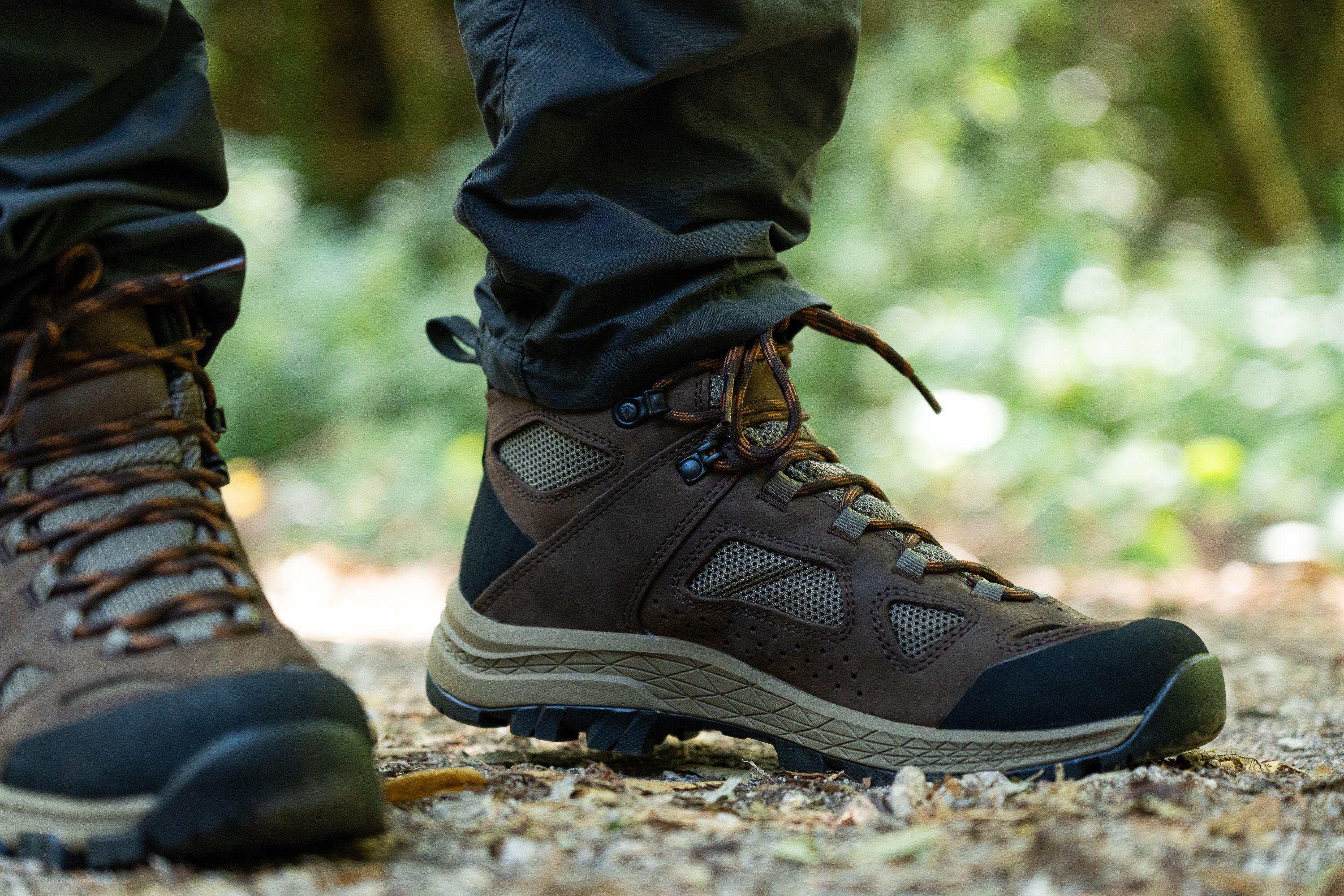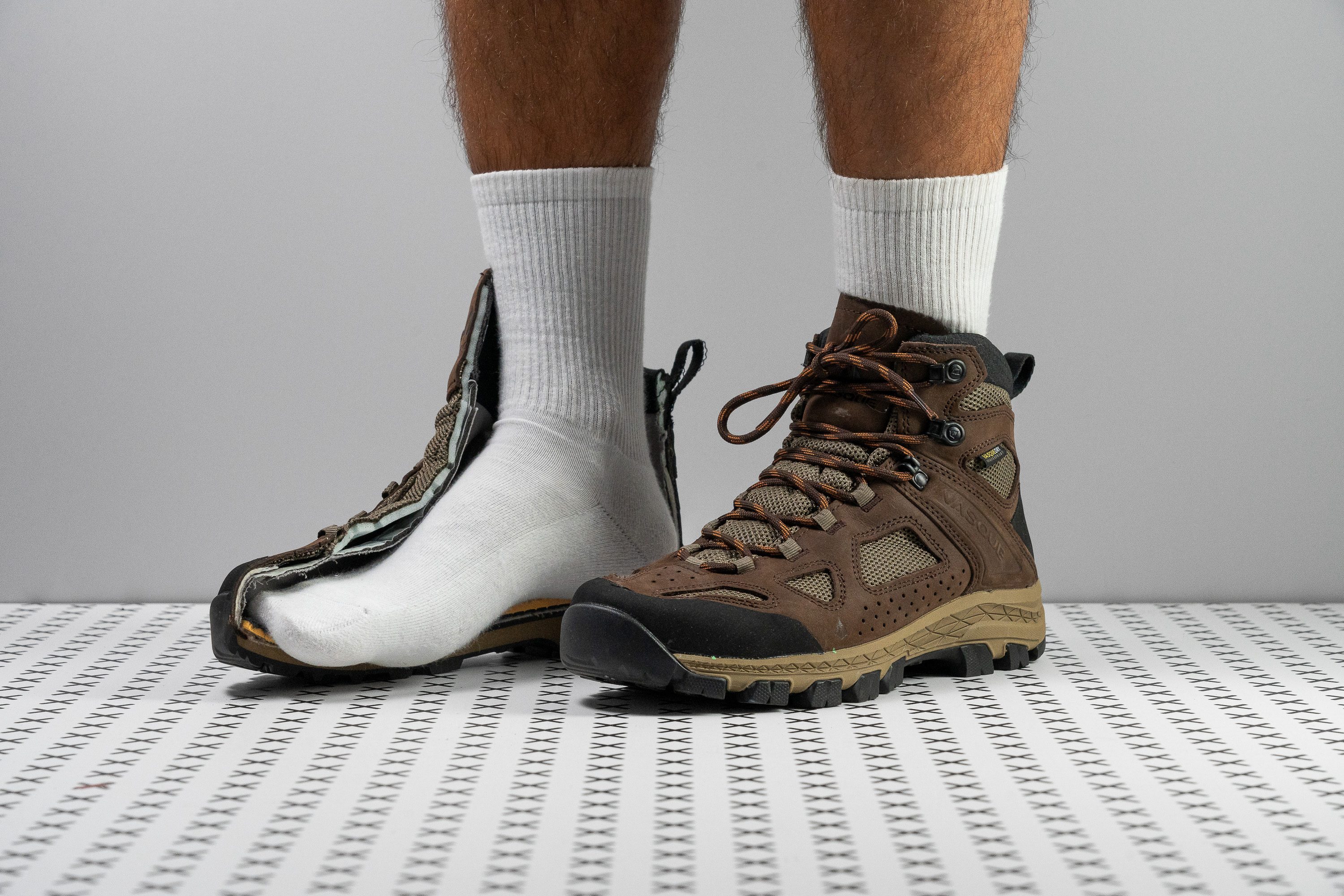Our verdict
Pros
- Fantastic stability and foot support
- Great underfoot protection
- Effective waterproofing (approved for deep creeks and puddles)
- Very hard-wearing rubber outsole
- Solid grip on various surfaces
- Great value for money
- Sustainable materials in several boot parts
Cons
- Upper materials could be more wear-resistant
- Short and slippery laces
Audience verdict
- Top 1% in Vasque hiking boots
Comparison
The most similar hiking boots compared
+ + Add a shoe | |||||
|---|---|---|---|---|---|
| Audience score | 84 Good! | 77 Decent! | 88 Great! | 84 Good! | |
| Price | £160 | £230 | £200 | £200 | |
| Trail terrain | Moderate | ModerateTechnical | ModerateTechnical | Technical | |
| Shock absorption | Low | - | Moderate | Low | |
| Energy return | Moderate | - | Low | Moderate | |
| Weight lab Weight brand | 19.9 oz / 563g | 20.6 oz / 583g 20.6 oz / 585g | 14.6 oz / 415g 16.6 oz / 470g | 23.4 oz / 663g 23.1 oz / 655g | |
| Lightweight | ✗ | ✗ | ✓ | ✗ | |
| Breathability | Warm | Warm | Warm | Warm | |
| Use | BackpackingDay HikingSnowBeginners | BackpackingDay HikingSnow | BackpackingDay HikingSnow | BackpackingDay HikingSnow | |
| Orthotic friendly | ✓ | ✓ | ✓ | ✓ | |
| Drop lab | 16.4 mm | 14.0 mm | 14.1 mm | 18.0 mm | |
| Size | Slightly small | Slightly small | Half size small | True to size | |
| Midsole softness | Firm | Balanced | Balanced | Balanced | |
| Difference in midsole softness in cold | Small | Small | Normal | Normal | |
| Heel counter stiffness | Stiff | Moderate | Moderate | Stiff | |
| Stiffness | Flexible | Moderate | Moderate | Stiff | |
| Outsole hardness | Average | Hard | Very hard | Average | |
| Waterproofing | Waterproof | Waterproof | Waterproof | Waterproof | |
| Material | LeatherMesh | Suede | Textile | Textile | |
| Season | Winter | Winter | Winter | Winter | |
| Toebox durability | Bad | Good | Good | Good | |
| Heel padding durability | Bad | Decent | Decent | Good | |
| Outsole durability | Decent | Good | Good | Decent | |
| Width / fit | Medium | Medium | Medium | Wide | |
| Toebox width | Medium | Narrow | Medium | Medium | |
| Lug depth | 4.6 mm | 4.0 mm | 4.3 mm | 4.7 mm | |
| Heel stack lab | 38.7 mm | 34.2 mm | 34.4 mm | 38.0 mm | |
| Forefoot | 22.3 mm | 20.2 mm | 20.3 mm | 20.0 mm | |
| Widths available | Normal | Normal | NormalWide | Normal | |
| Technology | - | Gore-TexVibram | Gore-TexOrtholite | Gore-TexOrtholite | |
| Cut | Mid cut | Mid cut | Mid cut | High cut | |
| Removable insole | ✓ | ✓ | ✓ | ✓ | |
| Ranking | #26 Bottom 36% | #39 Bottom 4% | #15 Top 37% | #25 Bottom 39% | |
| Popularity | #37 Bottom 9% | #41 Bottom 1% | #2 Top 5% | #7 Top 18% |
Who should buy
We highly recommend the Vasque Breeze if you are in search of a versatile boot that is comfortable for a day hike but also has enough support for a multi-day backpacking adventure with a heavy pack. Not to mention that it is also very reasonably priced.

Who should NOT buy
First released in 2004, the silhouette of the Vasque Breeze hasn't changed a lot since then. And even though the boot shows great performance on the trails, we felt as if it was somewhat dated compared to the current market of hiking boots.
Before going for this Vasque boot, we would recommend exploring options like the Salomon X Ultra 4 Mid GTX which is lighter, nimbler, and very well-fitting, or the La Sportiva Ultra Raptor II Mid GTX which is exceptionally lightweight but still stable and comfortable.
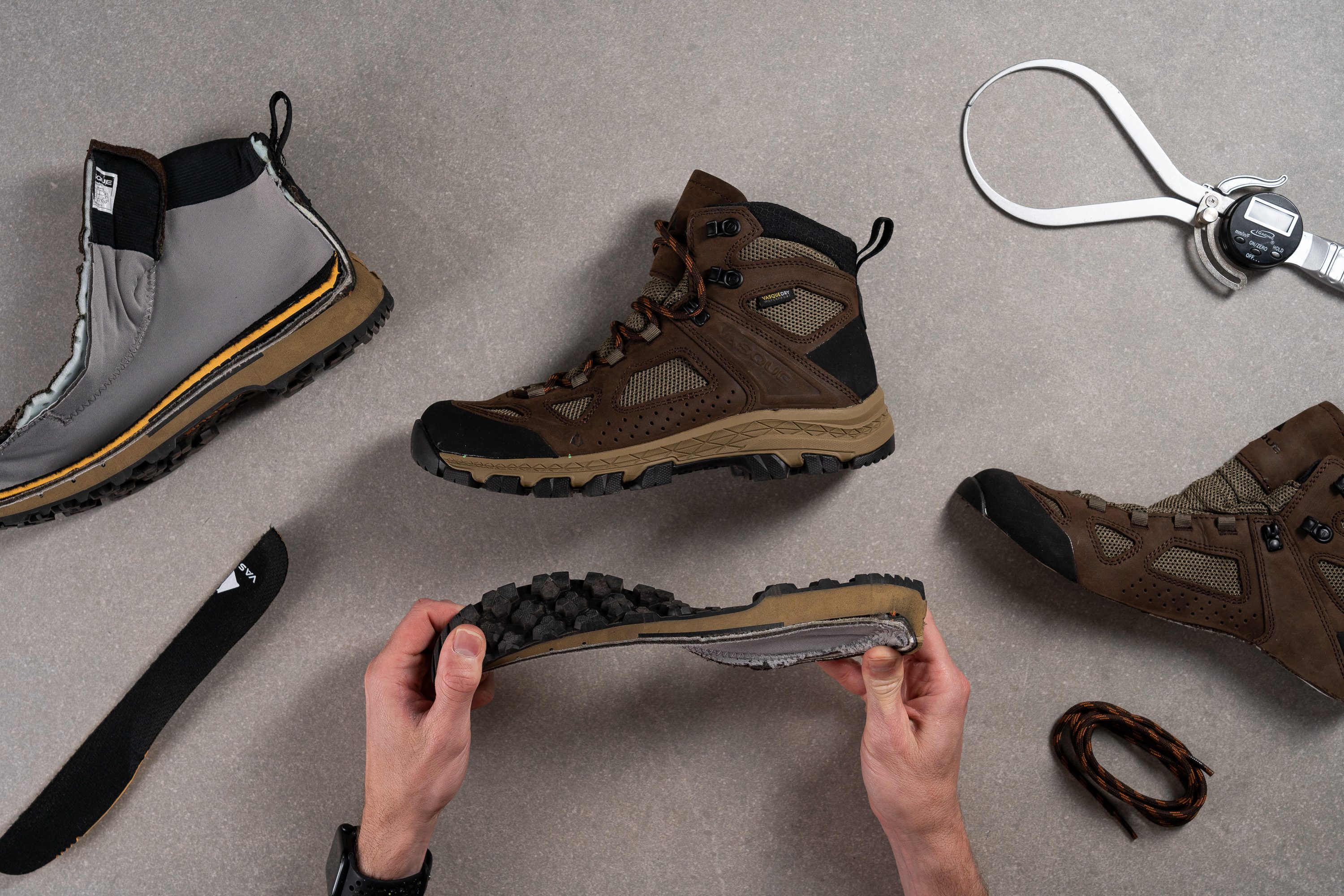
Cushioning
Shock absorption
Our lab tests confirmed that the firm and sturdy platform of the Vasque Breeze has little compression, resulting in a below-average shock absorption measurement of 84 SA.
This means that your feet and joints still get the necessary impact protection, but firmness and stability prevail underfoot.
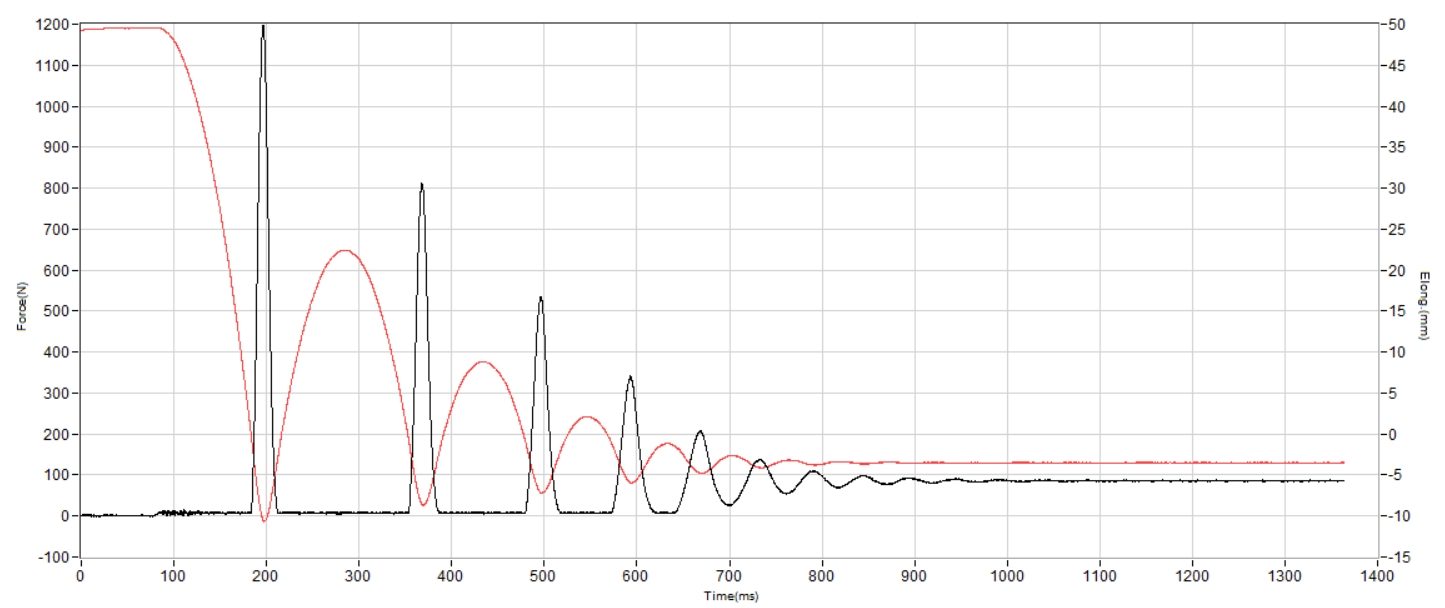
| Breeze | 84 SA |
| Average | 93 SA |
Energy return
But this Vasque boot doesn't feel completely flat and dull thanks to its moderate energy return of 51.8%. The elasticity of its midsole components helps to keep the ride dynamic and not so taxing on the body, especially given the lesser shock absorption.
| Breeze | 51.8% |
| Average | 50.5% |
Heel stack
Getting the Vasque Breeze, you can expect a good amount of underfoot protection and buffering from the trail. We found that this boot packs enough stack even for the longer hikes.

Our calliper showed a heel height of 38.7 mm which is right in the middle of backpacking boots. Getting into rocky and rooty situations won't leave your feet battered with this amount of underfoot material.
| Breeze | 38.7 mm |
| Average | 36.3 mm |
Forefoot stack
As for the forefoot stack, we measured it at a pretty average height of 22.3 mm. Typical for a hiking boot.

It kept the balls of our feet protected without compromising the ground feel. We felt in control of our footwork at all times.
| Breeze | 22.3 mm |
| Average | 23.0 mm |
Drop
A steeper heel-to-toe drop is expected in a backpacking boot. So we weren't surprised to see a 16.4 mm difference in height between the Breeze's heel and forefoot height.
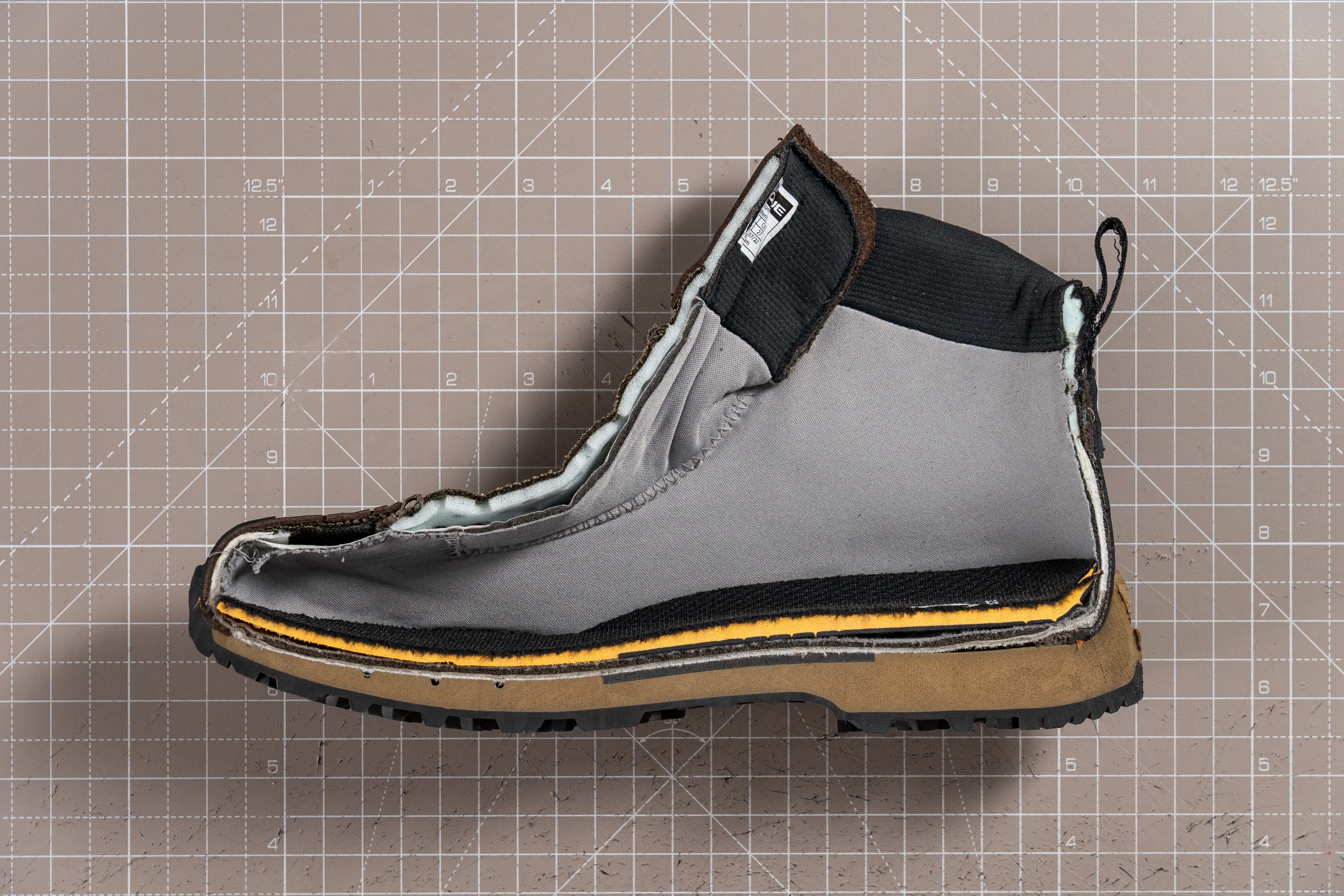
When you carry a heavier load, the elevated position of your heel helps to relieve the pressure on the ankle and the Achilles while also adding more cushioning where it's most needed - under the heel.
| Breeze | 16.4 mm |
| Average | 13.3 mm |
Midsole softness
As a more traditional hiking boot, the Vasque Breeze relies on a firm midsole for better stability. It is the complete opposite of the marshmallowy Hoka Kaha 2 GTX in that regard.
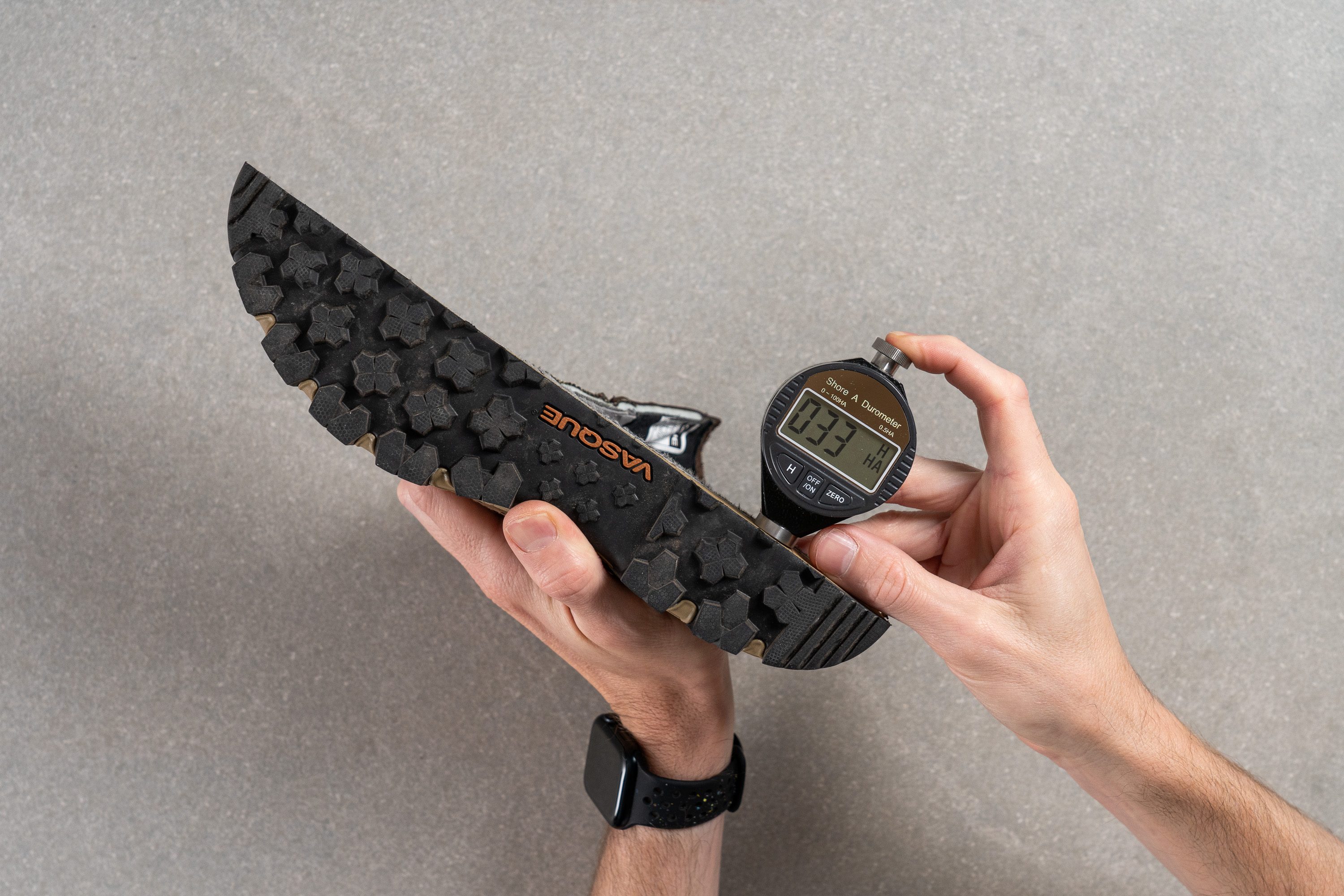
Based on our Shore A durometer measurement of 32.9 HA, the cushioning foam of this boot is about 20% firmer than the average. The foam in question is the brand's proprietary Enduralast Bio EVA (made from 20% sugarcane by the way).
Even though it is on the firmer side, the Breeze doesn't feel like a firm brick that leaves your feet beaten up after the hike. Some softness is still there to soften the blow of stepping on hard terrain.
| Breeze | 32.9 HA |
| Average | 28.4 HA |
Size and fit
Size
Vasque Breeze fits slightly small (19 votes).
Toebox width - widest part
We discovered that the Vasque Breeze offers ample toe space to accommodate thick socks and moderate foot swelling. Our caliper showed 102.3 mm in the widest area of its toebox which is the same as the average of hiking boots.
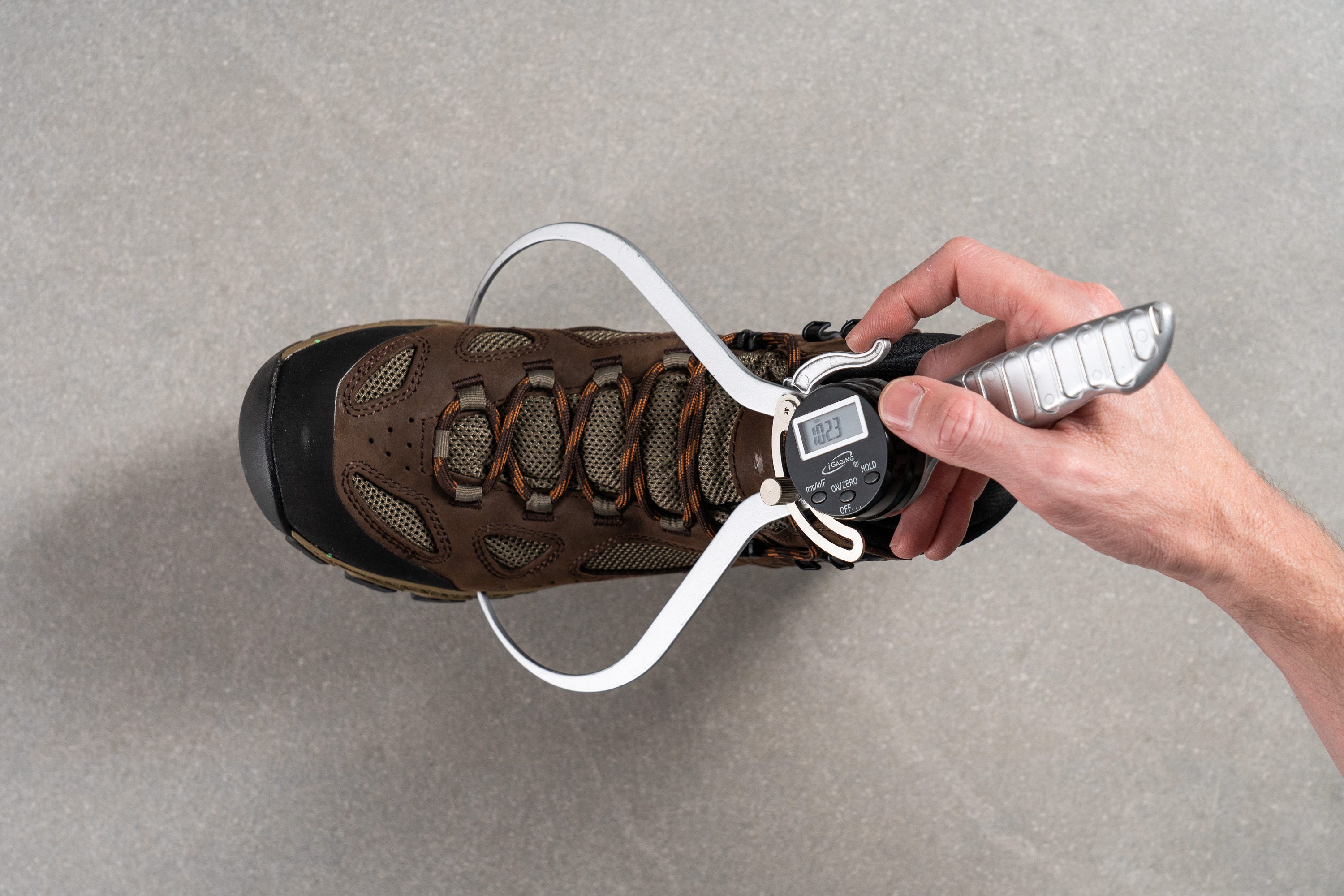
And if you need even more room, the Breeze is also available in wide.
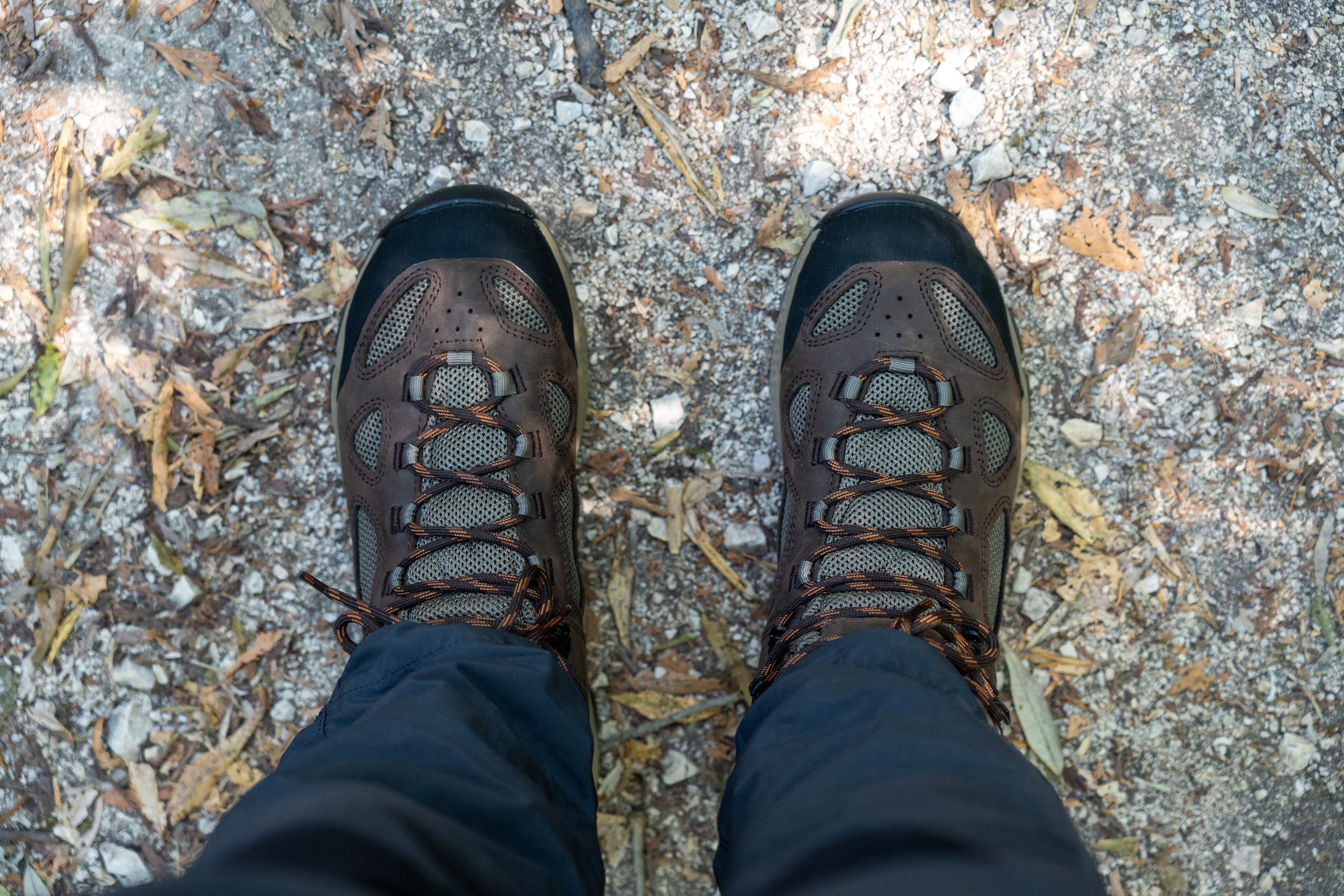
This test follows an older methodology, which is why you don't see recently tested shoes in the chart. Results from different methodologies can not be compared.
| Breeze | 102.3 mm |
| Average | 102.1 mm |
Toebox width - big toe
The boot has a nice and rounded toebox shape that didn't squeeze our toes at all. In the widest part, it showed 81.4 mm on our caliper which is even a bit wider than many other hiking boots.
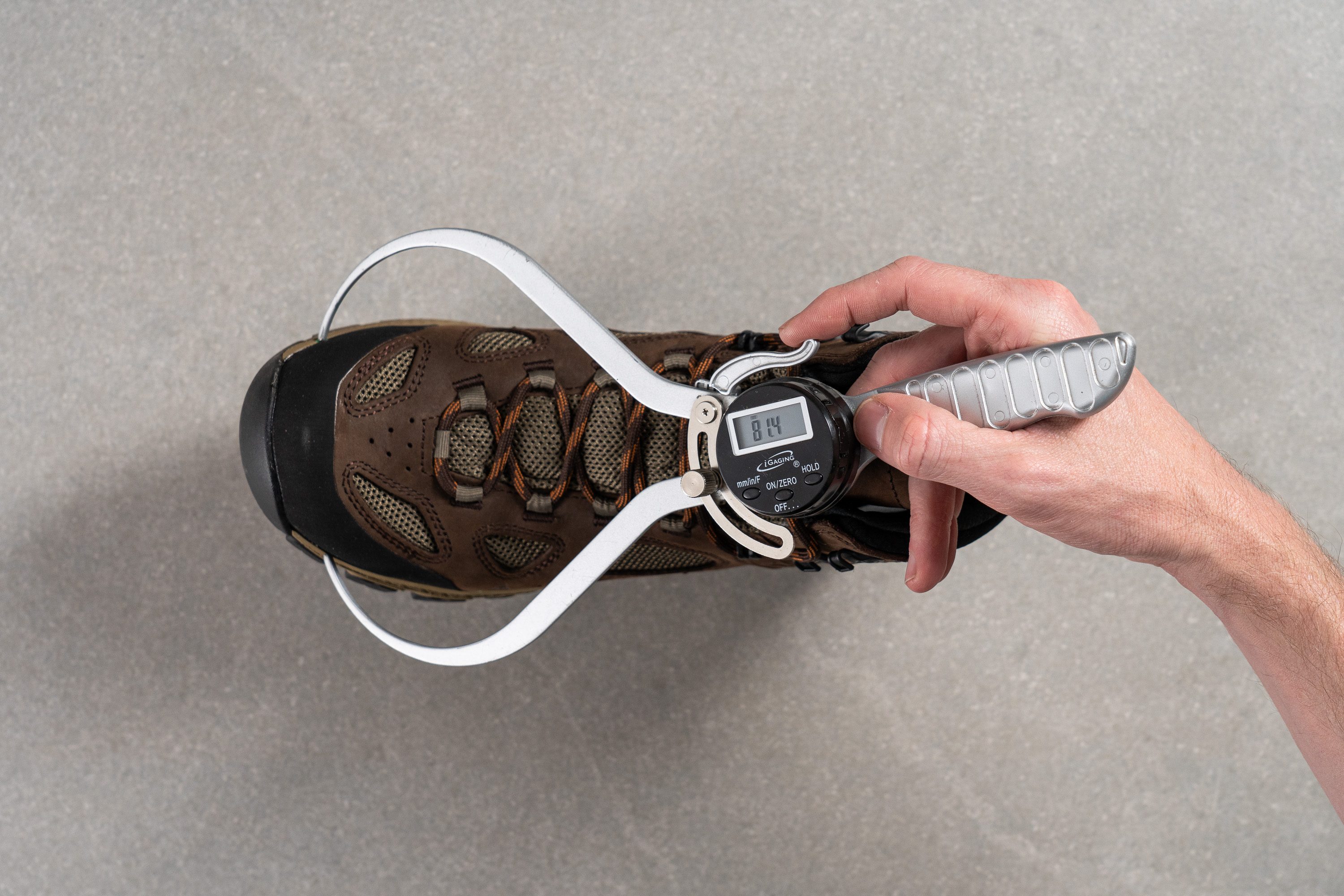
This test follows an older methodology, which is why you don't see recently tested shoes in the chart. Results from different methodologies can not be compared.
| Breeze | 81.4 mm |
| Average | 78.6 mm |
Laces
On the downside, we have reservations about the boot's laces. Thick and rounded, they don't allow to cinch down the fit very tightly and are also somewhat slippery.
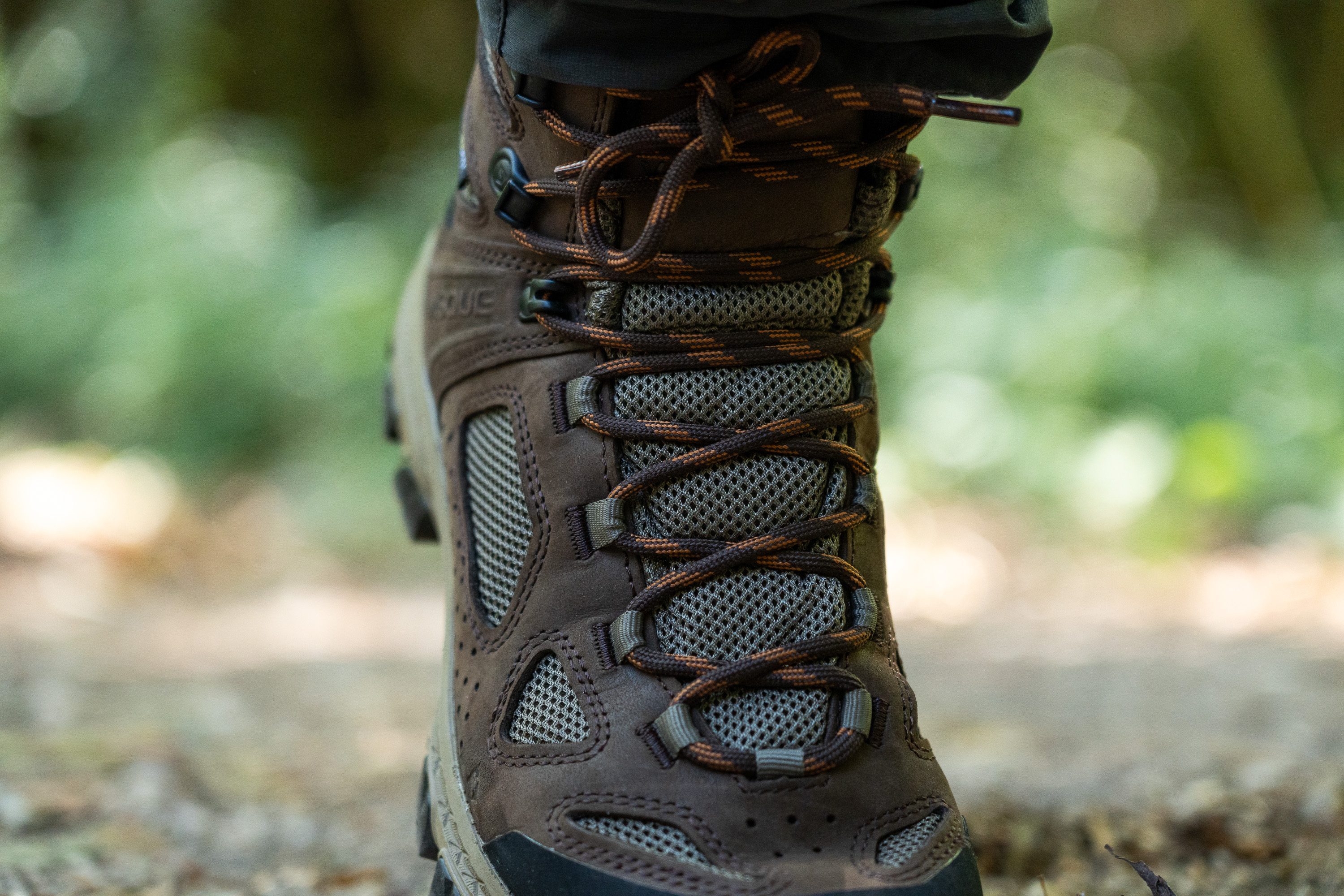
A double-knot could potentially solve the issue but it's not possible because the laces are also too short.
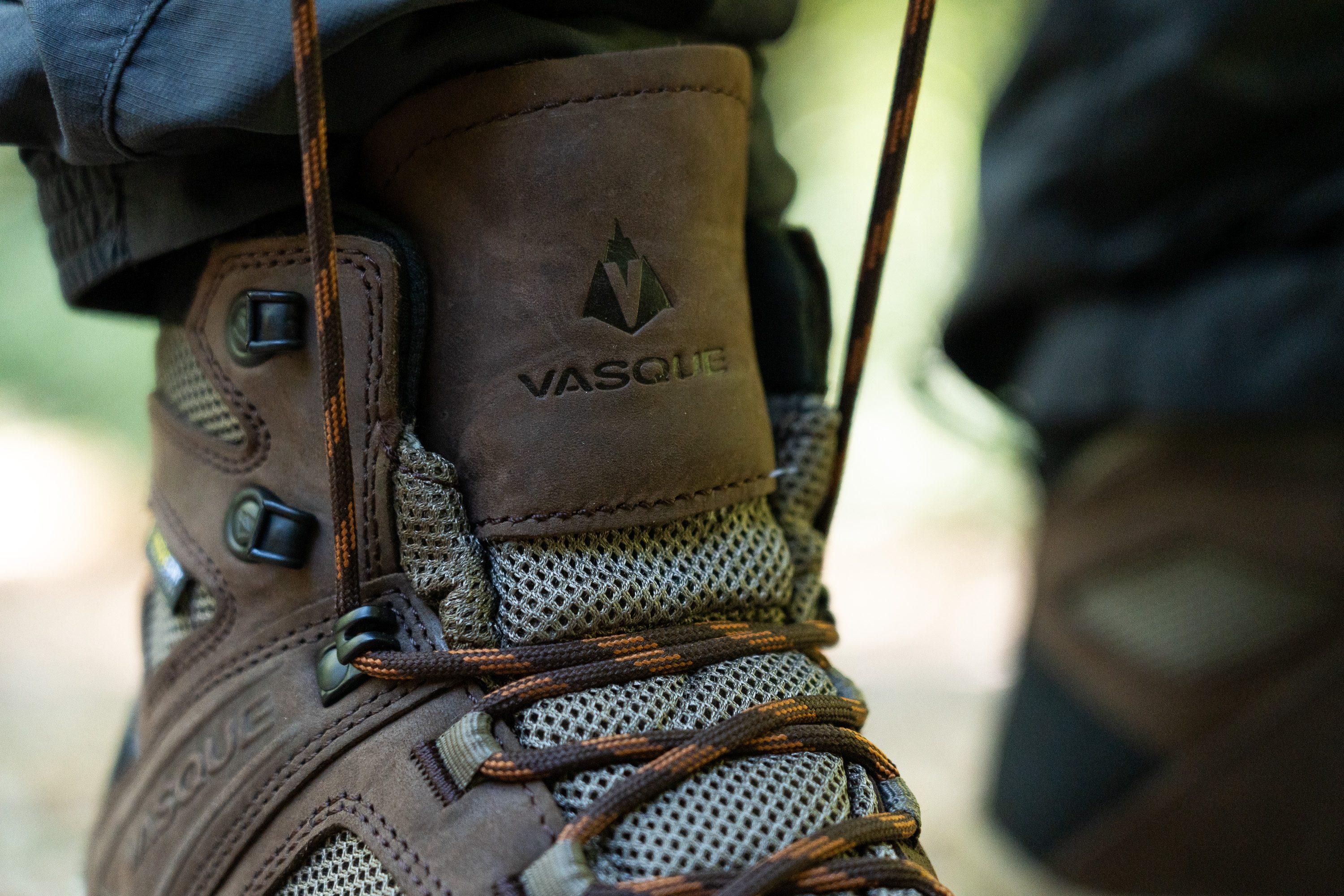
Skipping the topmost lace hooks is a potential remedy but it's not very optimal for the overall fit.
Traction / Grip
Lug depth
The brand's proprietary Vasque Trail Strider outsole is very reminiscent of the classic boot tread pattern. The clover-like lugs point in different directions providing a pretty effective grip in most hiking scenarios, except for the most extreme ones (i.e. deep mud, rock-heavy trails, ice).
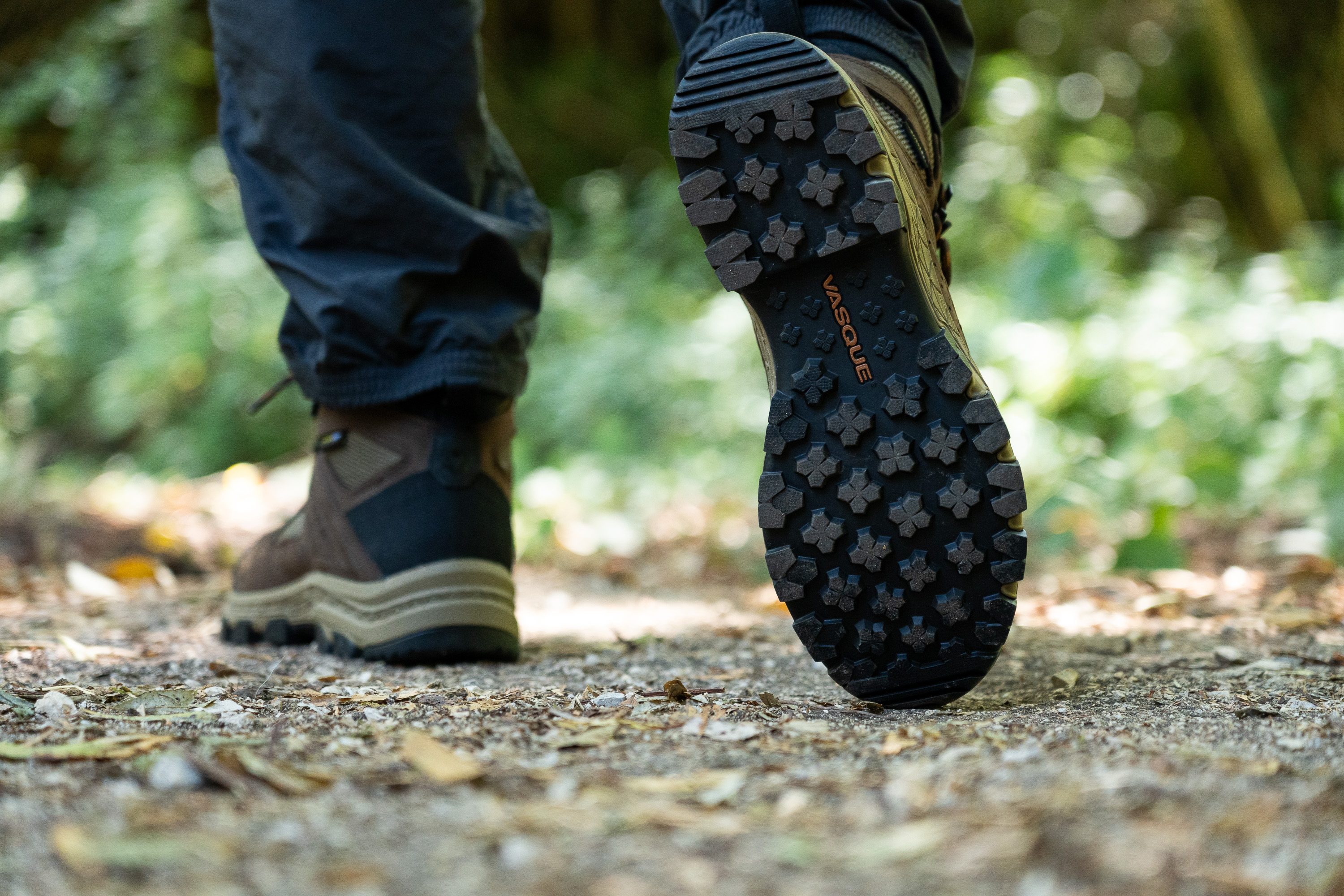
The above-average depth of these lugs (4.6 mm) also inspired confidence on mixed terrain with a little bit of everything - loose rocks, roots, puddles, creeks, and moss.

| Breeze | 4.6 mm |
| Average | 4.3 mm |
Flexibility / Stiffness
Even though it is a pretty classic backpacking boot, the Vasque Breeze wasn't as stiff as we expected.
It took a very minimal amount of force (18.3N) to bend the boot to a 30-degree angle, according to our shoe flexing tester. That is significantly less than it takes an average hiking boot, not mention stiff backpacking boots.
This pliability adds comfort to the ride but definitely limits this boot's target audience. Most hikers prefer stiffer setups for hauling heavy packpacks all day long.
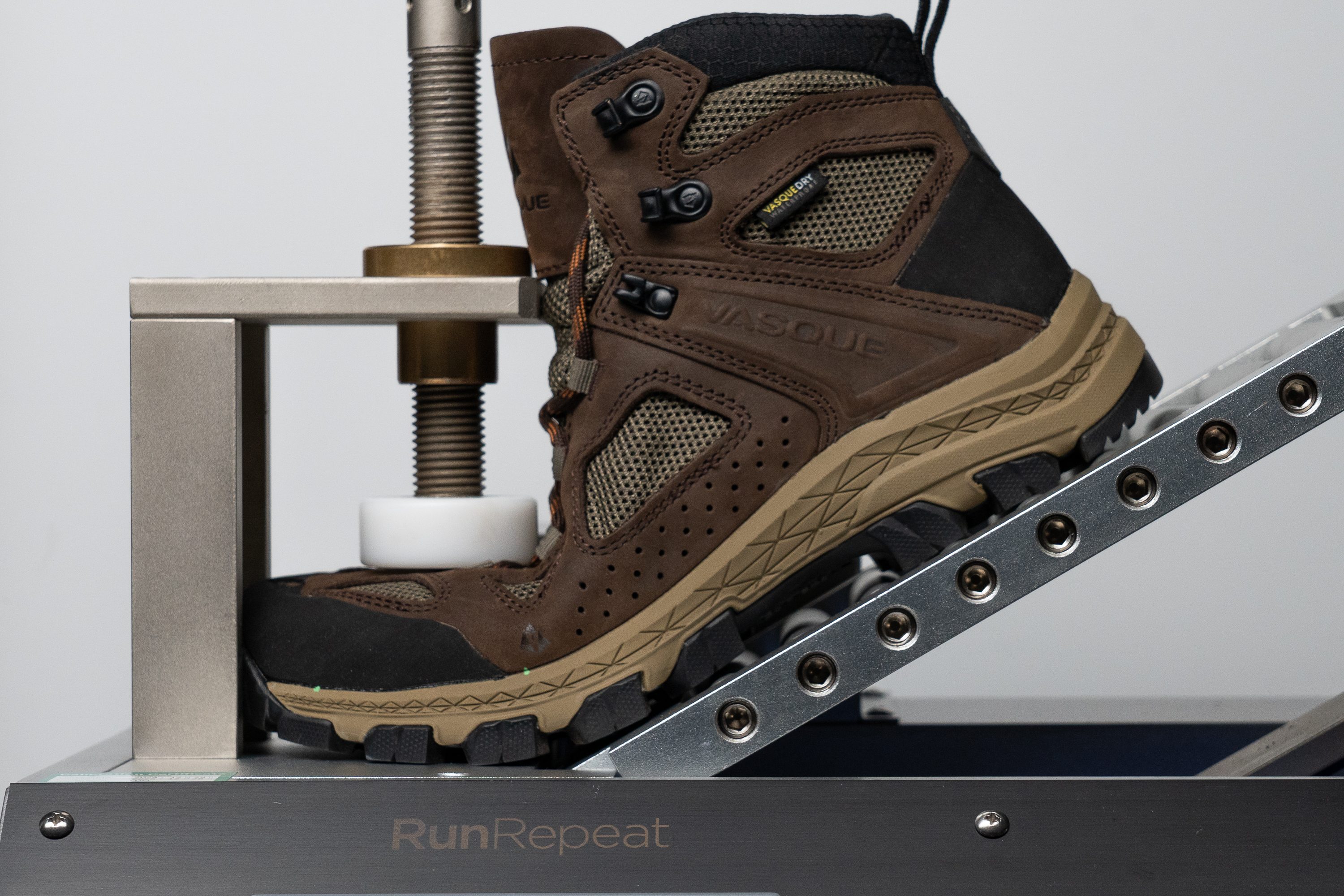
| Breeze | 18.3N |
| Average | 31.5N |
Stiffness in cold (%)
We were also pleasantly surprised by the fact that the Breeze didn't get overly stiff in low temperatures.
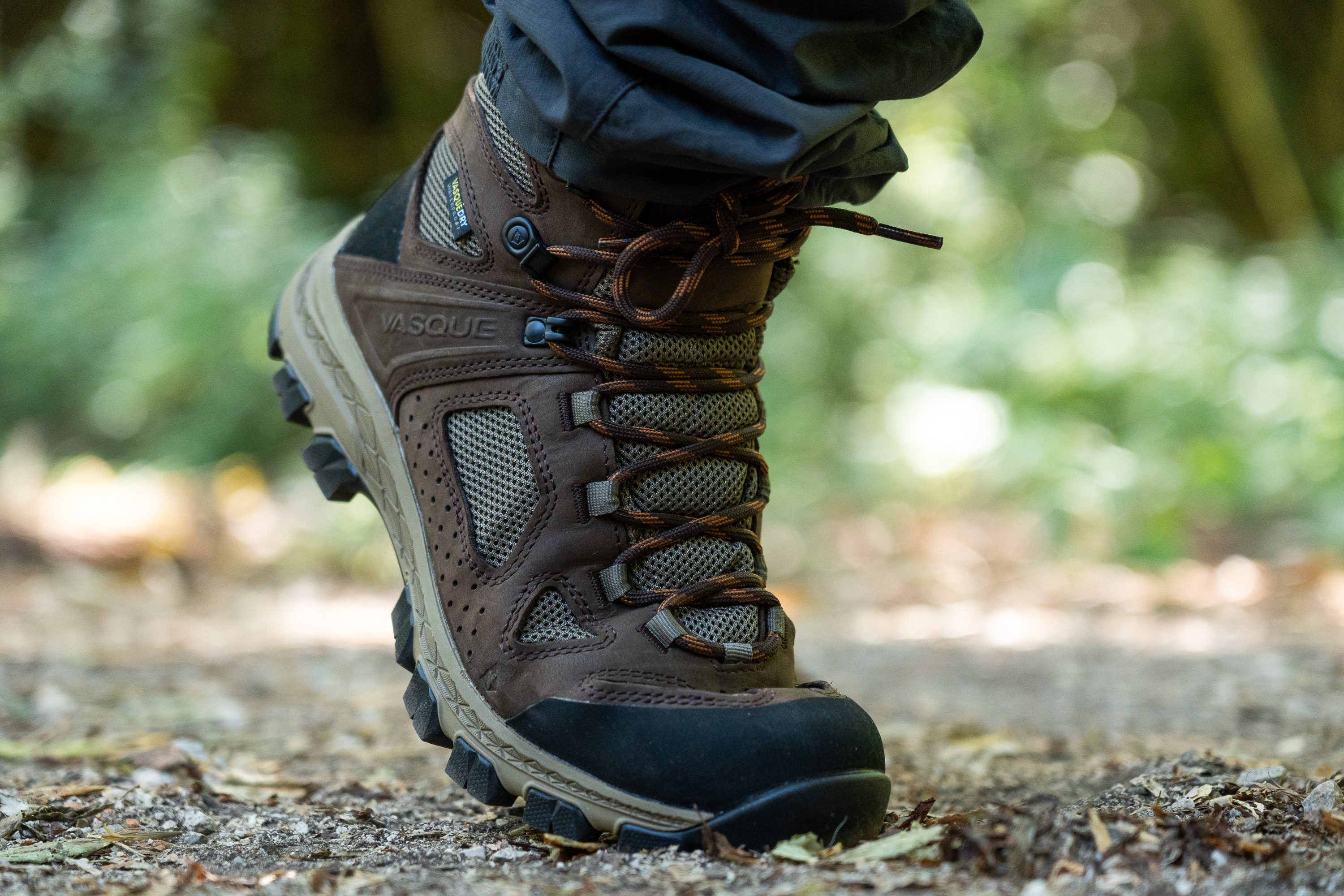
After a 20-minute freezer test, the boot only stiffened up by 17.4% and still required less force to bend compared to most boots.

| Breeze | 17% |
| Average | 24% |
Weight
Originally designed over a quarter century ago, the Vasque Breeze retains a traditional backpacking boot silhouette which is reflected in its above-average weight as well.
Showing 19.9 oz (563g) in a men's US size 9, it is about an ounce heavier than the average hiking boot.

But let's be fair and compare the Breeze to other backpacking boots of its kind. The average weight of this bunch comes in at a higher 21 oz (600g) which puts the Vasque Breeze into the lighter range.
But if you want to explore lighter options from Vasque, look for boots with an LT abbreviation in their name (stands for "lightweight").
| Breeze | 19.9 oz (563g) |
| Average | 18.7 oz (531g) |
Breathability
The name of the Vasque Breeze can be misleading. Even though the brand positions this hiking boot as a breathable one, it is still a waterproof one so there is a limit to how breathable it can get.
Our smoke test above clearly demonstrates that mesh inserts and toebox perforations don't allow much airflow in this Vasque boot.
As far as our subjective experience goes, the Breeze wasn't as warm as the other waterproof boots we've tested. But neither did it have enough ventilation to earn an extra breathability point. Thus, we gave it the lowest breathability score of 1 out of 5.
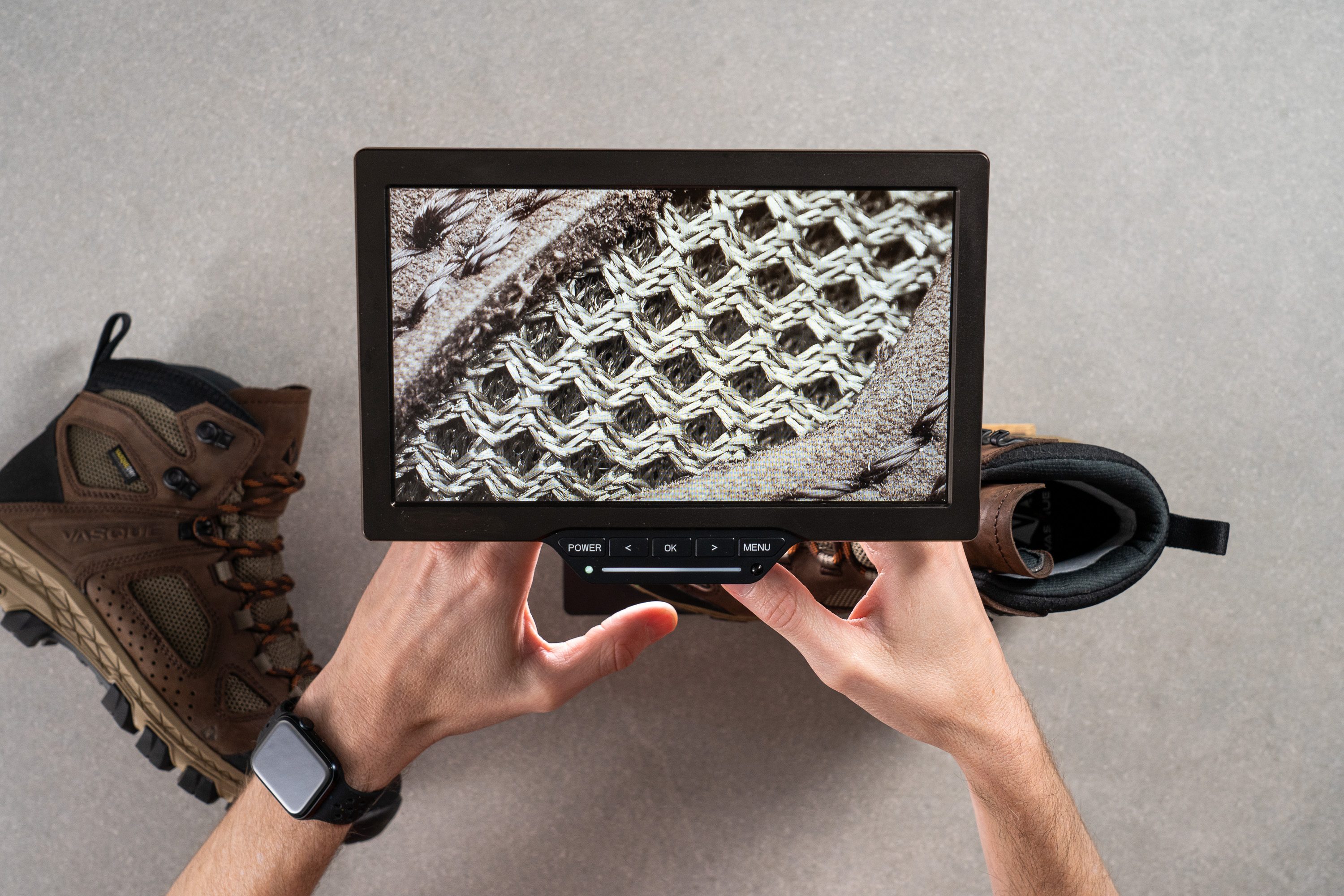
Even though mesh dominates the upper of the Vasque Breeze, it makes very little difference with a waterproof membrane beneath it.
Speaking of which...
| Breeze | 1 |
| Average | 1.3 |
Waterproofing
Since the 2022 redesign of the boot, it received a new proprietary VasqueDry technology instead of the widely known Gore-Tex membrane. While this caused worries among the longtime fans of the Breeze, we see no reason for concern here.
The technology proved its effectiveness in the outdoor tests keeping our feet nice and dry. The fact that it's comprised of 25% recycled materials without losing watertightness is impressive too!
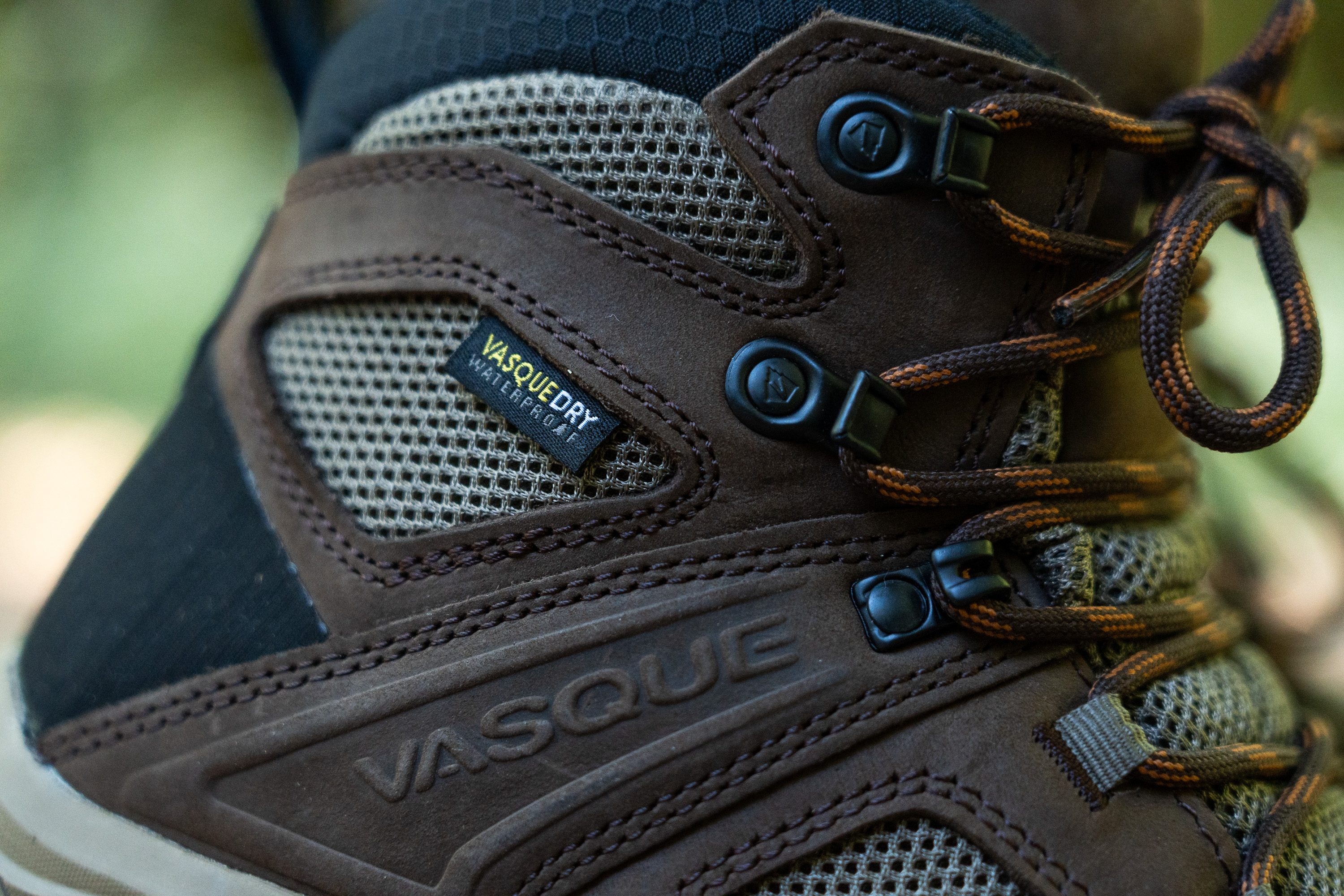
Stability
Lateral stability test
If stability is high on your priority list for hiking/backpacking boots, the Vasque Breeze is a solid option to consider.
Our wear tests revealed its top-notch foot stability and foot containment which eliminates wobbling even when a heavy pack is involved.
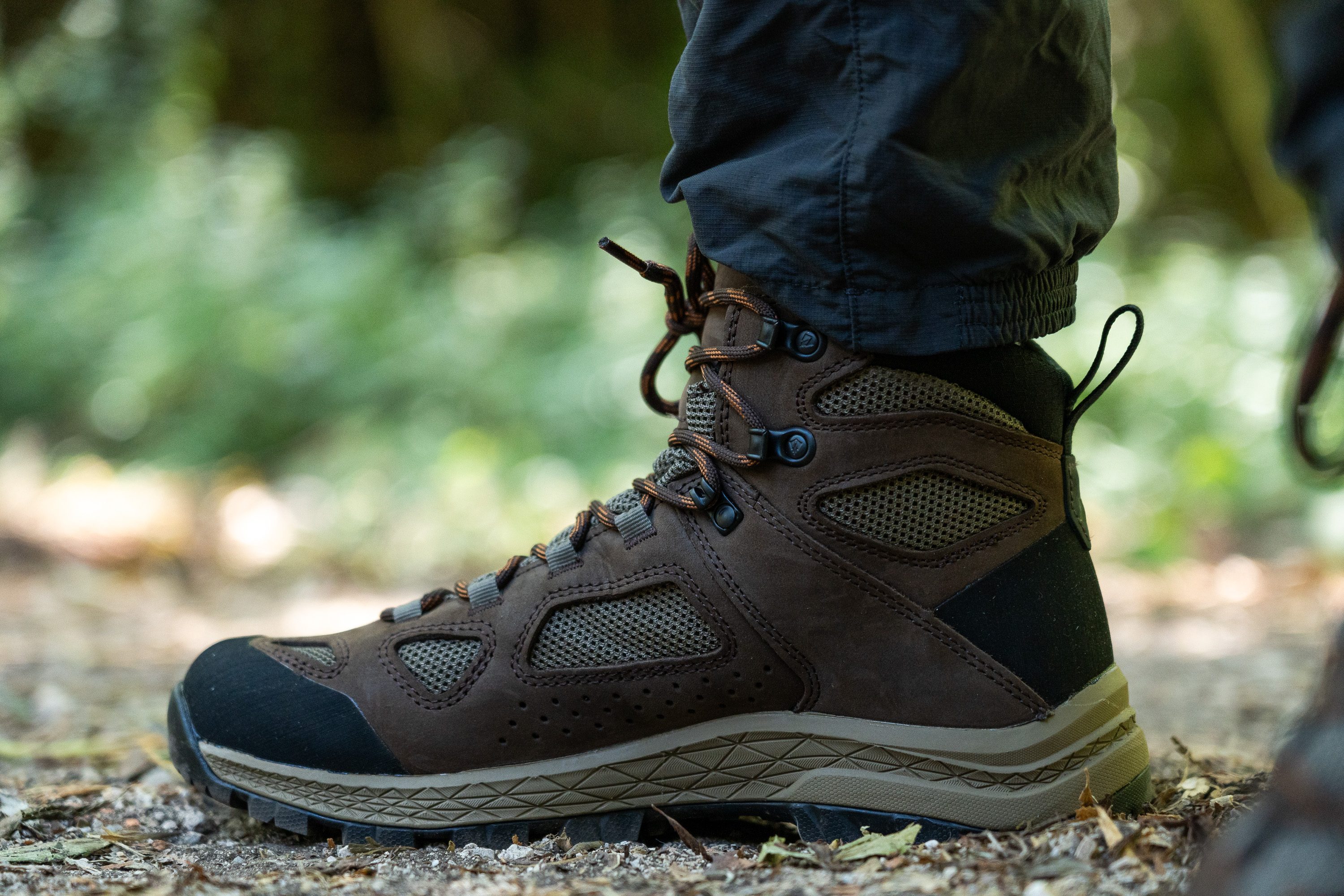
Torsional rigidity
We found it impossible to twist the boot in our manual test which convinced us to rate its torsional rigidity with a maximum stiffness score - 5 out of 5.
And when the boot doesn't buckle, it doesn't let the foot do the same.
| Breeze | 5 |
| Average | 4.4 |
Heel counter stiffness
A highly supportive heel counter is another crucial component of any backpacking boot. And the Vasque Breeze nails it considering how sturdy and structured its rearfoot is.
As you can see, we could hardly push or squeeze the back of the boot in our manual test. Thus, we had no reservations when assessing its heel counter stiffness with the highest score of 5.
The boot kept our ankles safely locked in lowering the risk of tottering with a backpack.
| Breeze | 5 |
| Average | 3.6 |
Midsole width - forefoot
We also found the landing area of this Vasque boot sufficiently broad for high-mileage backpacking objectives over varied terrain.
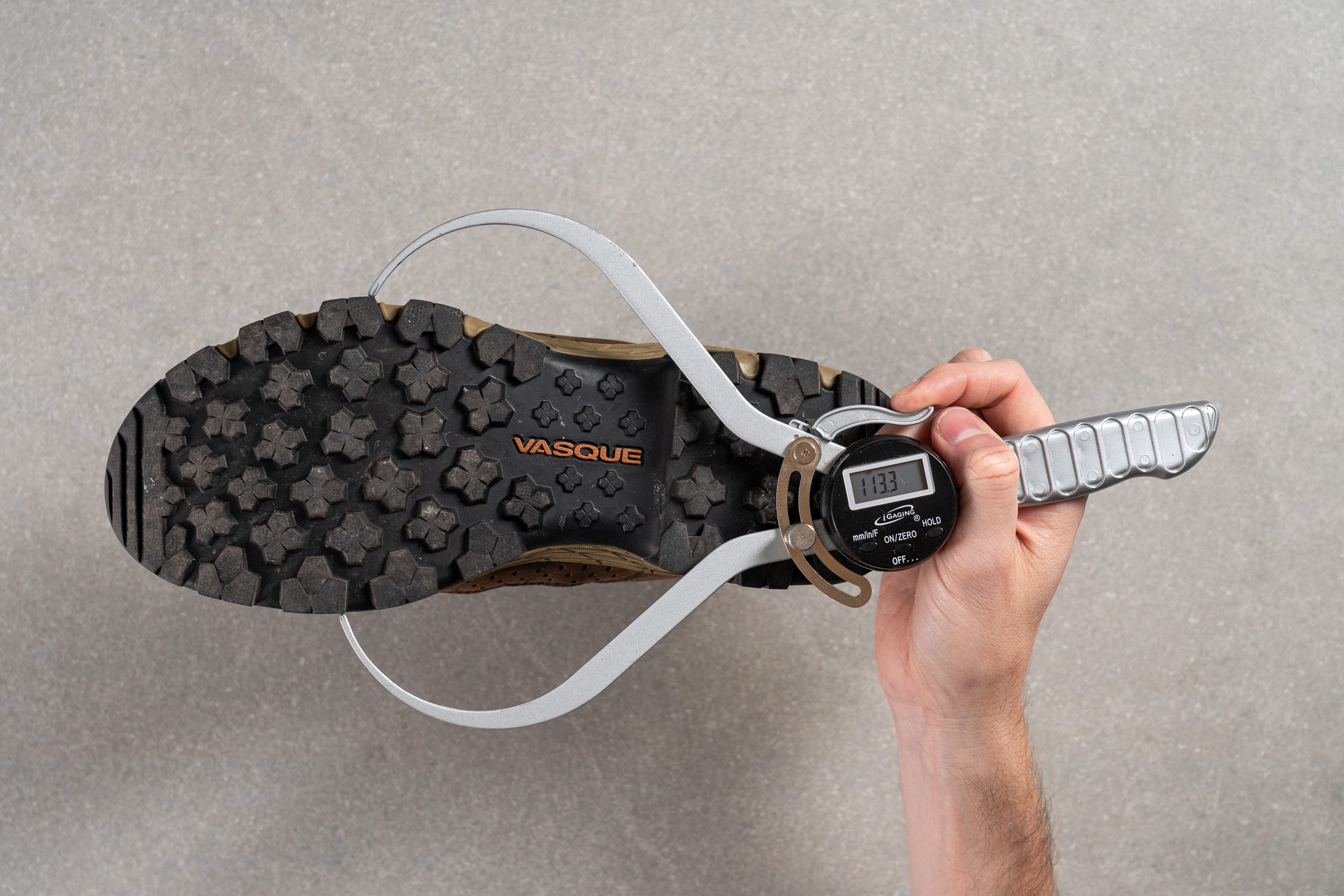
The widest area of the Breeze's midsole clocks in at 113.3 mm which is on par with the hiking boot average.
| Breeze | 113.3 mm |
| Average | 111.5 mm |
Midsole width - heel
We also found the boot's heel sufficiently wide at 85.9 mm.
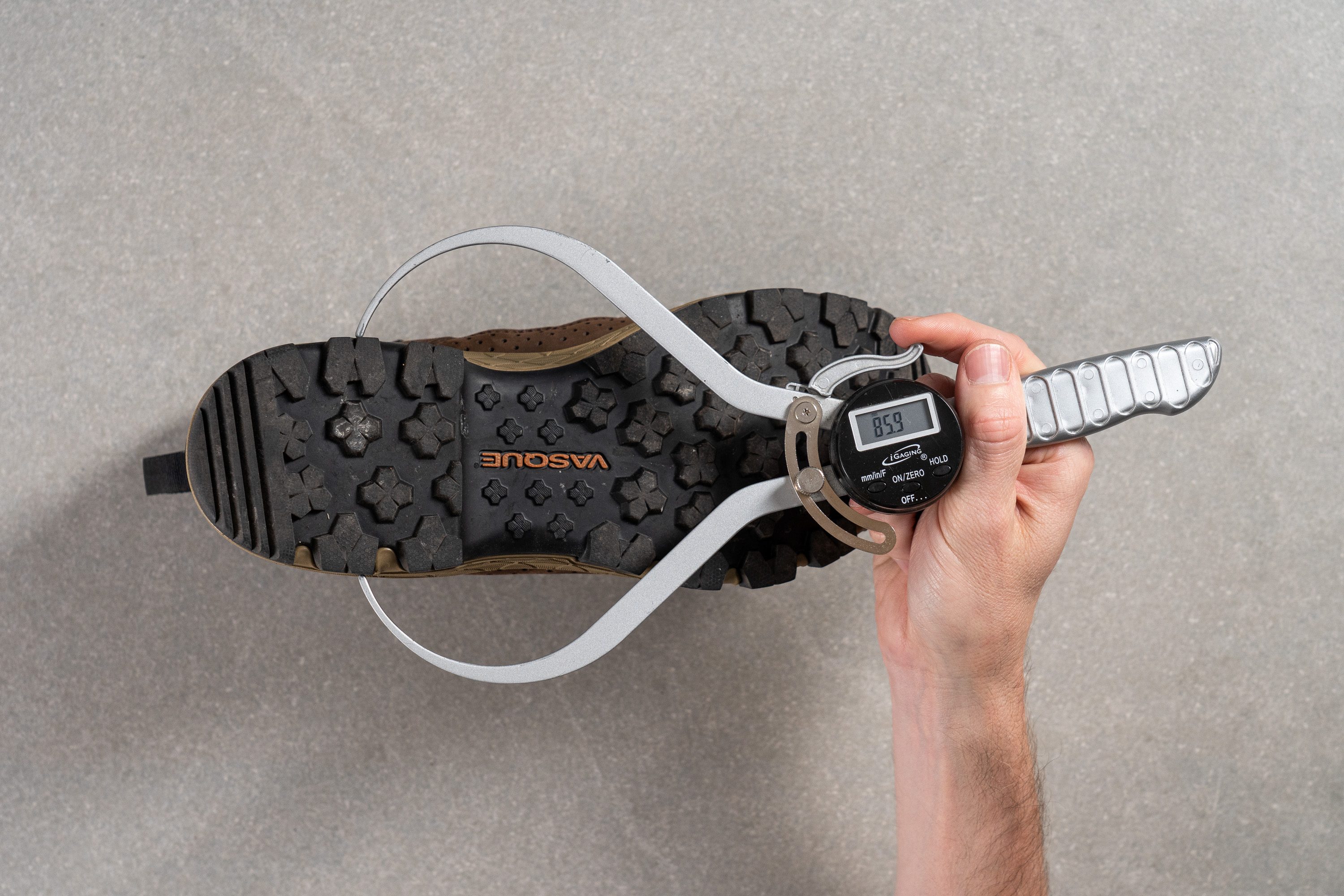
Even though the Vasque Breeze's midsole dimensions don't beat width records, we found them to be just right for the boot's intended purpose. It is stable enough for hilly terrain without being too cumbersome.
| Breeze | 85.9 mm |
| Average | 87.6 mm |
Durability
Toebox durability
Bumping into rocks and roots or wading through sharp bushes, it is essential to have enough protection in the toe area of your hiking boots.
In addition to the regular toe bumper, the Vasque Breeze features a thick nubuck layer with a rubbery rand on top of it. Equipped with a Dremel and sandpaper, we set out to test its abrasion resistance.
Unfortunately, 12 seconds was enough to burn through the rubber piece completely. That is a bad sign for long-term longevity so we had to lower the toebox durability score to 3 out of 5.
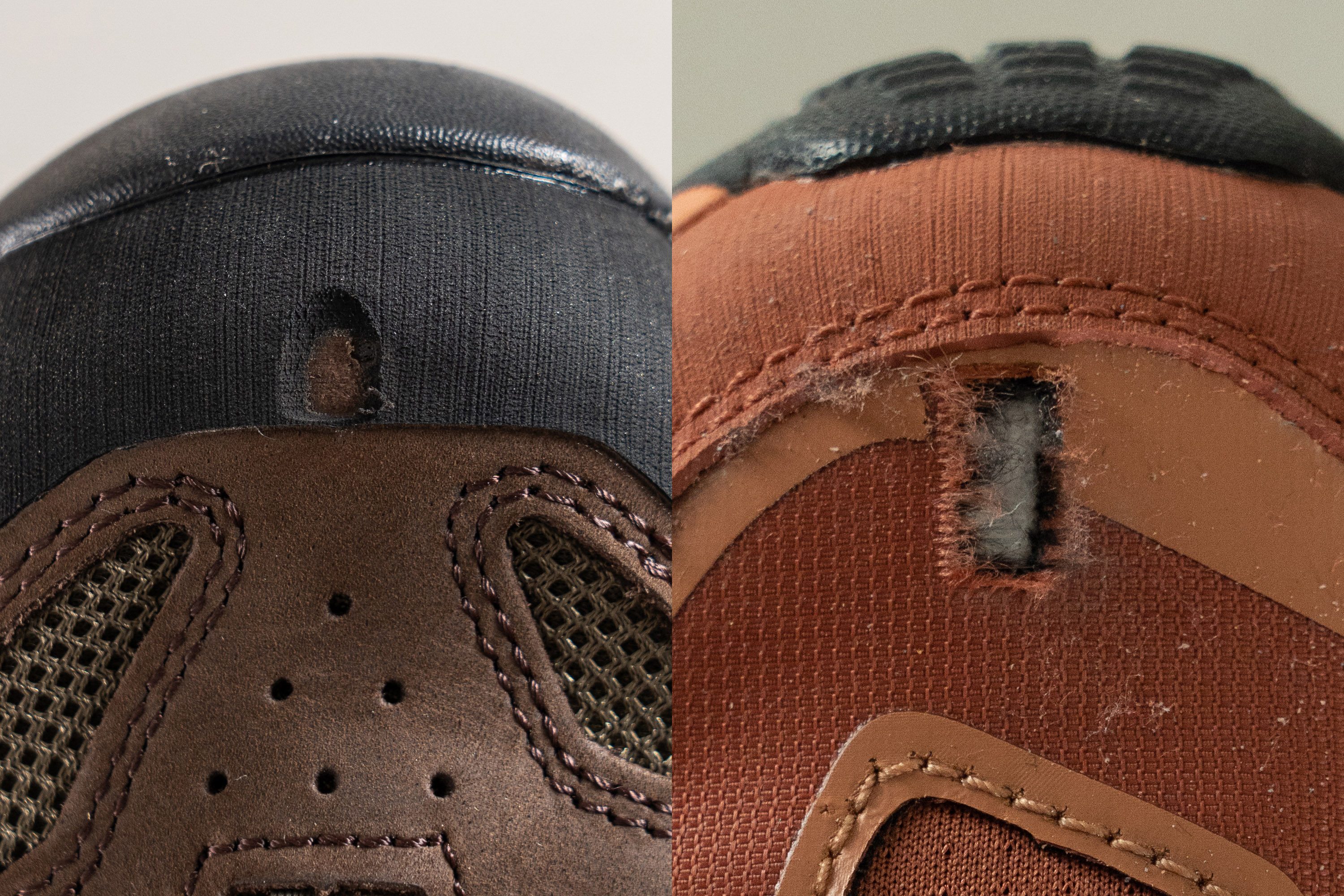
On the bright side, it is a bit better reinforced than some of the other hiking shoes we've tested. Those were left with a glaring hole!
| Breeze | 3 |
| Average | 4.3 |
Heel padding durability
Even though it's often overlooked, the inner durability of a hiking boot is just as important as the exterior one. As someone who tears the inner lining of their boots pretty fast due to overpronation, we can tell once the hole is there, the waterproofing suffers greatly.
That's why we ruthlessly use our Dremel to drill the boot's inner heel lining with sandpaper to check how well it holds up.

To our disappointment, the lining of the Breeze tore almost completely after only 4 seconds...This is another red flag for this boot's upper longevity which lowers the durability score to only 2 out of 5.
| Breeze | 2 |
| Average | 3.6 |
Outsole hardness
Thankfully, Vasque didn't cut corners on the outsole durability of the Breeze boot. We found its hardness and abrasion resistance quite solid for its price point.

A high durometer reading of 87.1 HC represents a nice and hard rubber compound that promises to be pretty tough.
| Breeze | 87.1 HC |
| Average | 87.1 HC |
Outsole durability
The perceived outsole durability of this Vasque boot was confirmed in our demanding Dremel test which involved drilling the rubber for 22 seconds at a high speed of 10K RPM.
With a dent of only 0.7 mm, the boot's proprietary rubber stood up to the test just brilliantly!
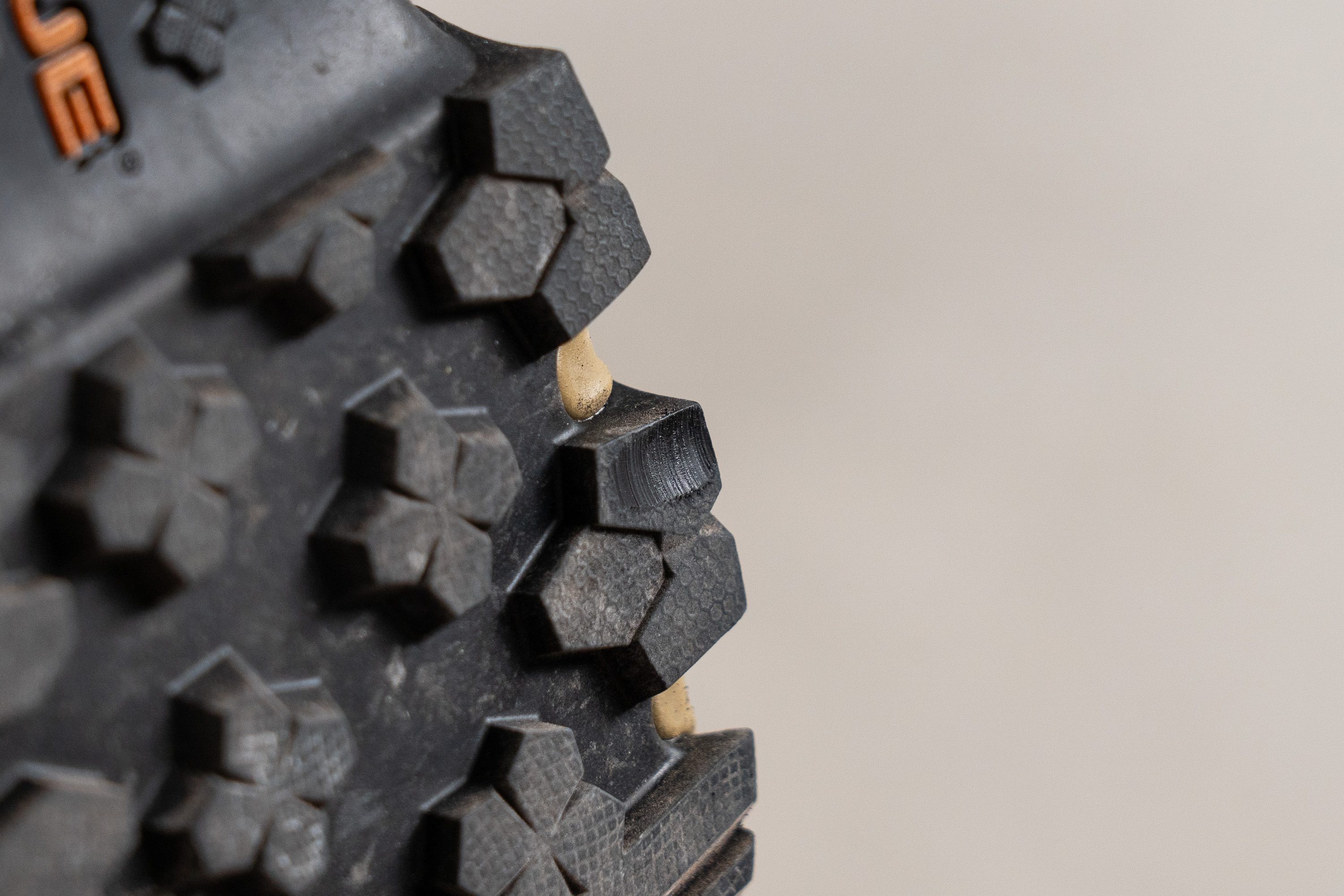
| Breeze | 0.7 mm |
| Average | 0.8 mm |
Outsole thickness
With a 2.5 mm rubber layer on top of 4.6 mm lugs, we have no doubts that the outsole of the Vasque Breeze is going to serve a good while.

| Breeze | 2.5 mm |
| Average | 2.9 mm |
Misc
Insole thickness
A fairly thick (6.9 mm) dual-density EVA insole is responsible for underfoot comfort in the Vasque Breeze.
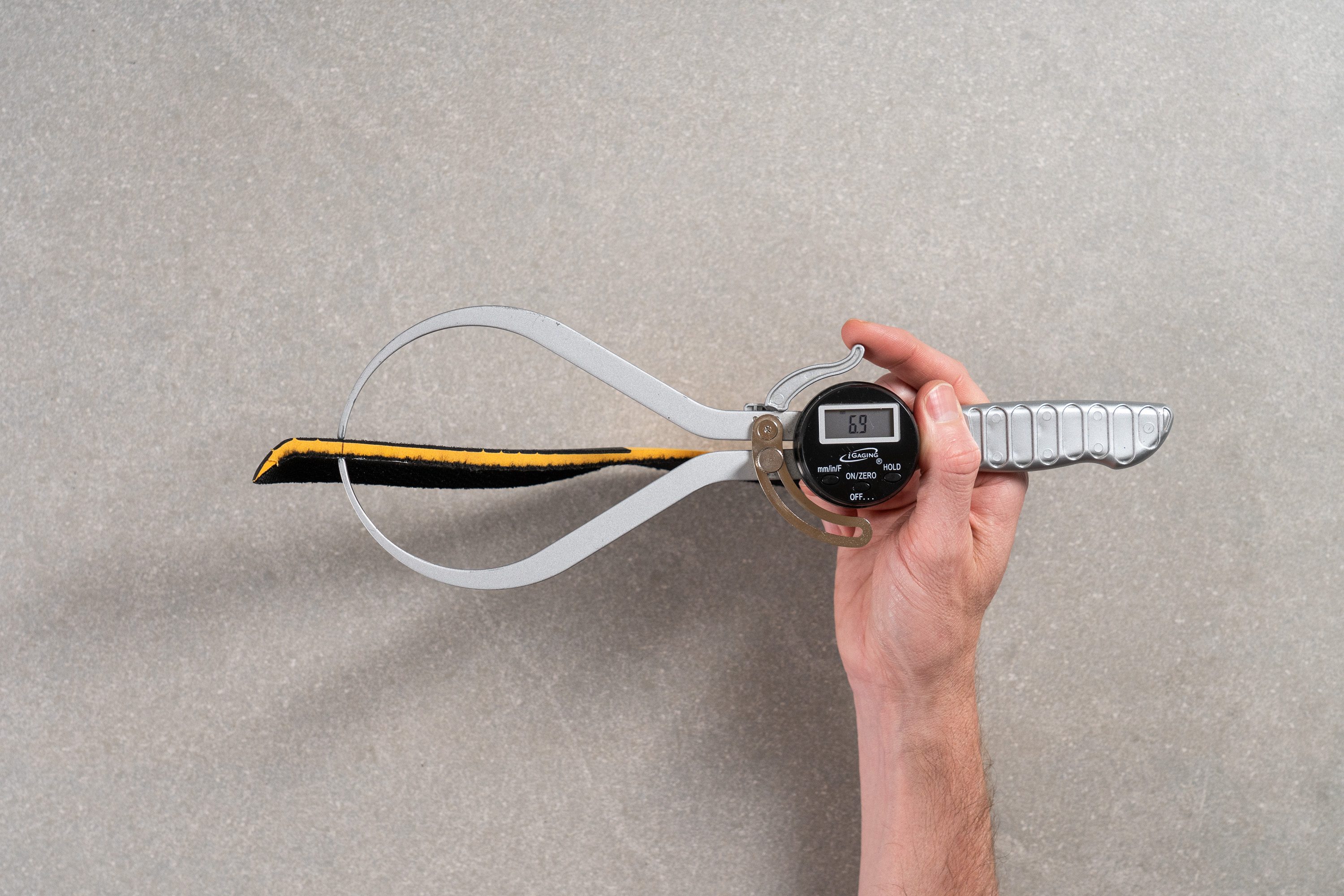
| Breeze | 6.9 mm |
| Average | 6.0 mm |
Removable insole
If you often use custom orthotics with your footwear or would like to elevate the comfort of the boot, you can easily do it thanks to the removable insole.

| Breeze | Yes |
Midsole softness in cold (%)
Keep in mind though that the Vasque Breeze is going to firm up in lower temperatures.
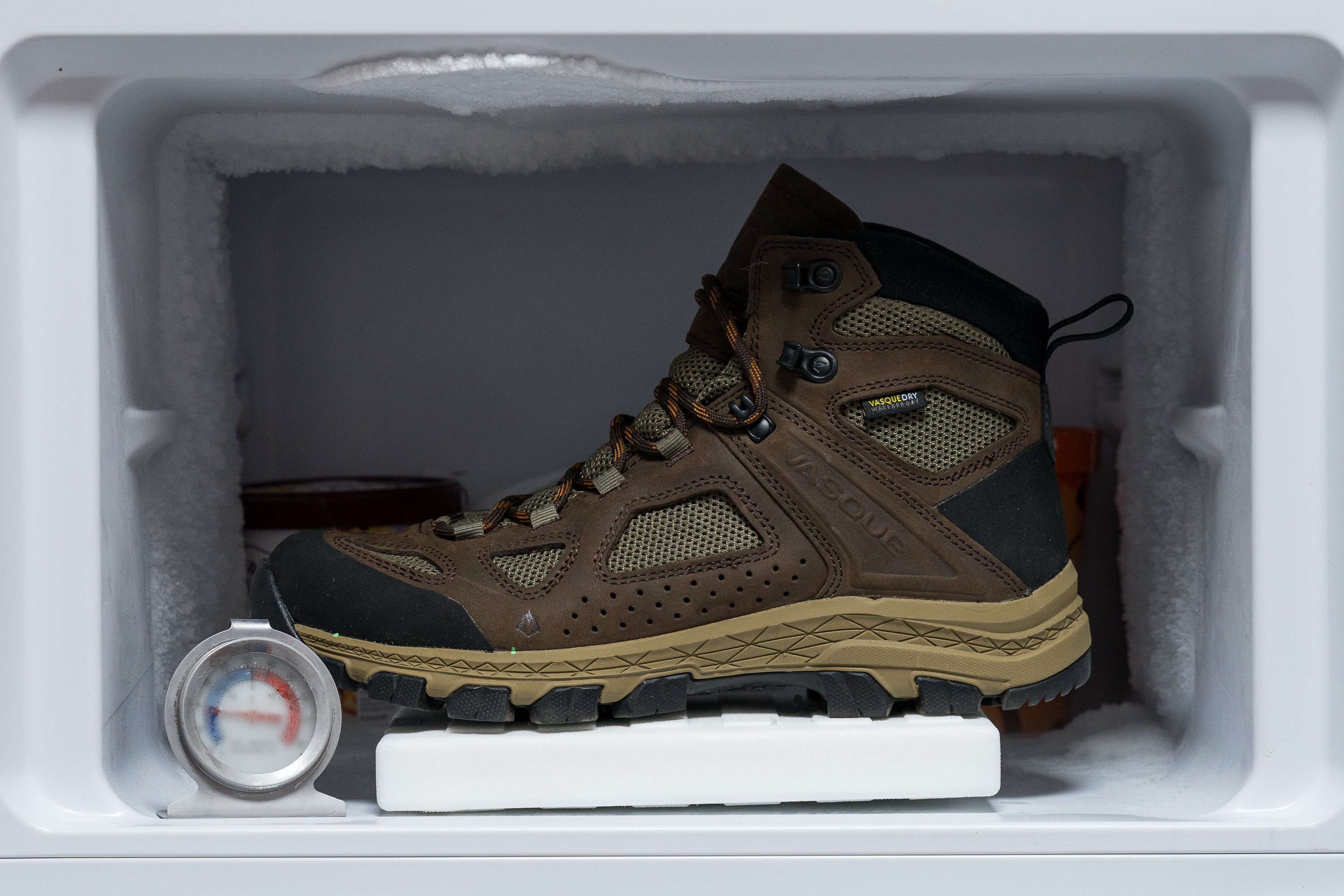
We found that 20 minutes of cold exposure in our freezer raised the durometer measurement to 39.4 HA which is 19.8% firmer compared to the one we measured at room temperature.
| Breeze | 20% |
| Average | 20% |
Reflective elements
This Vasque boot has a rather traditional design and reflective elements are not part of it.
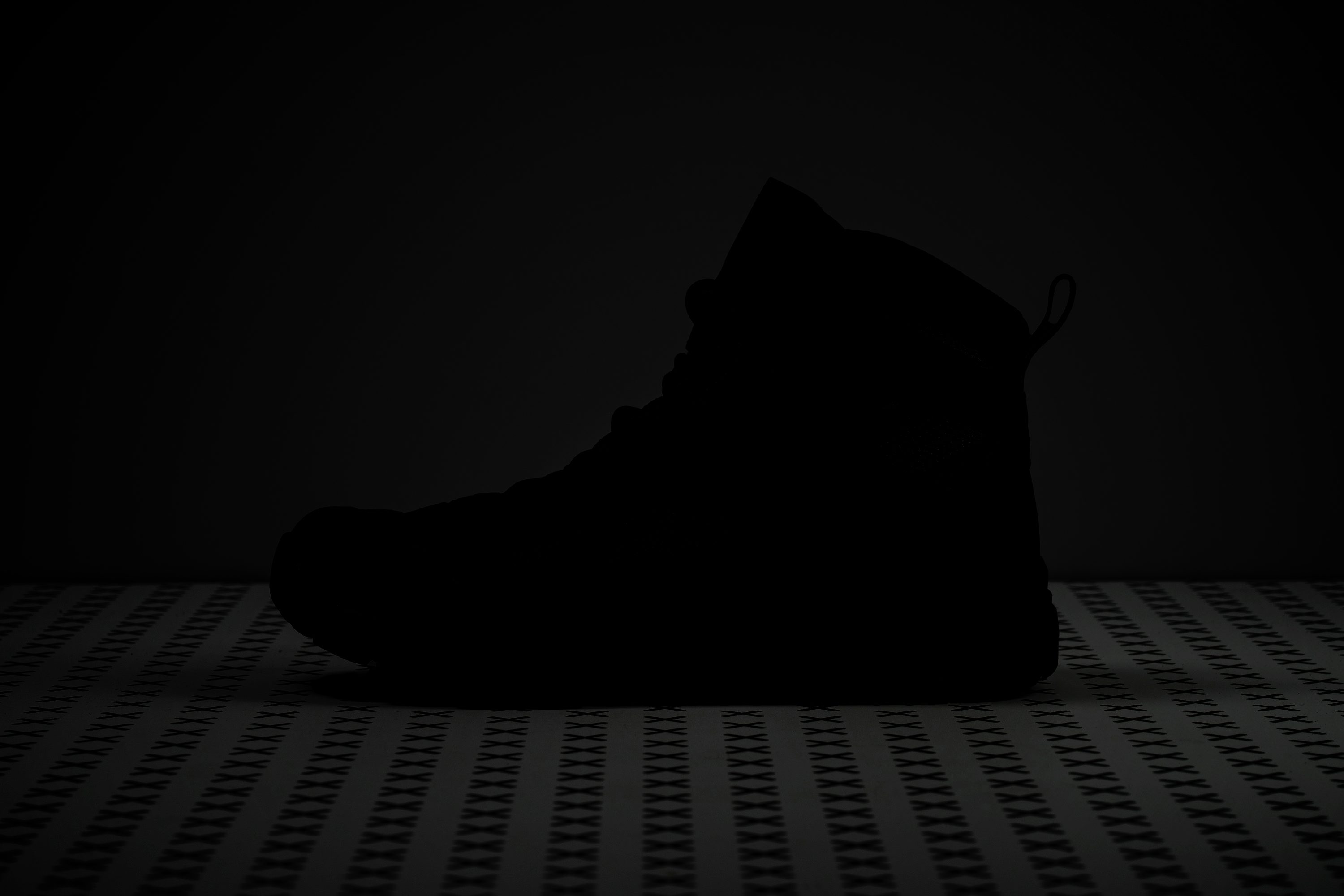
| Breeze | No |
Tongue padding
Even the boot's thinner-than-average tongue (7.8 mm) didn't help to free up the lace length.
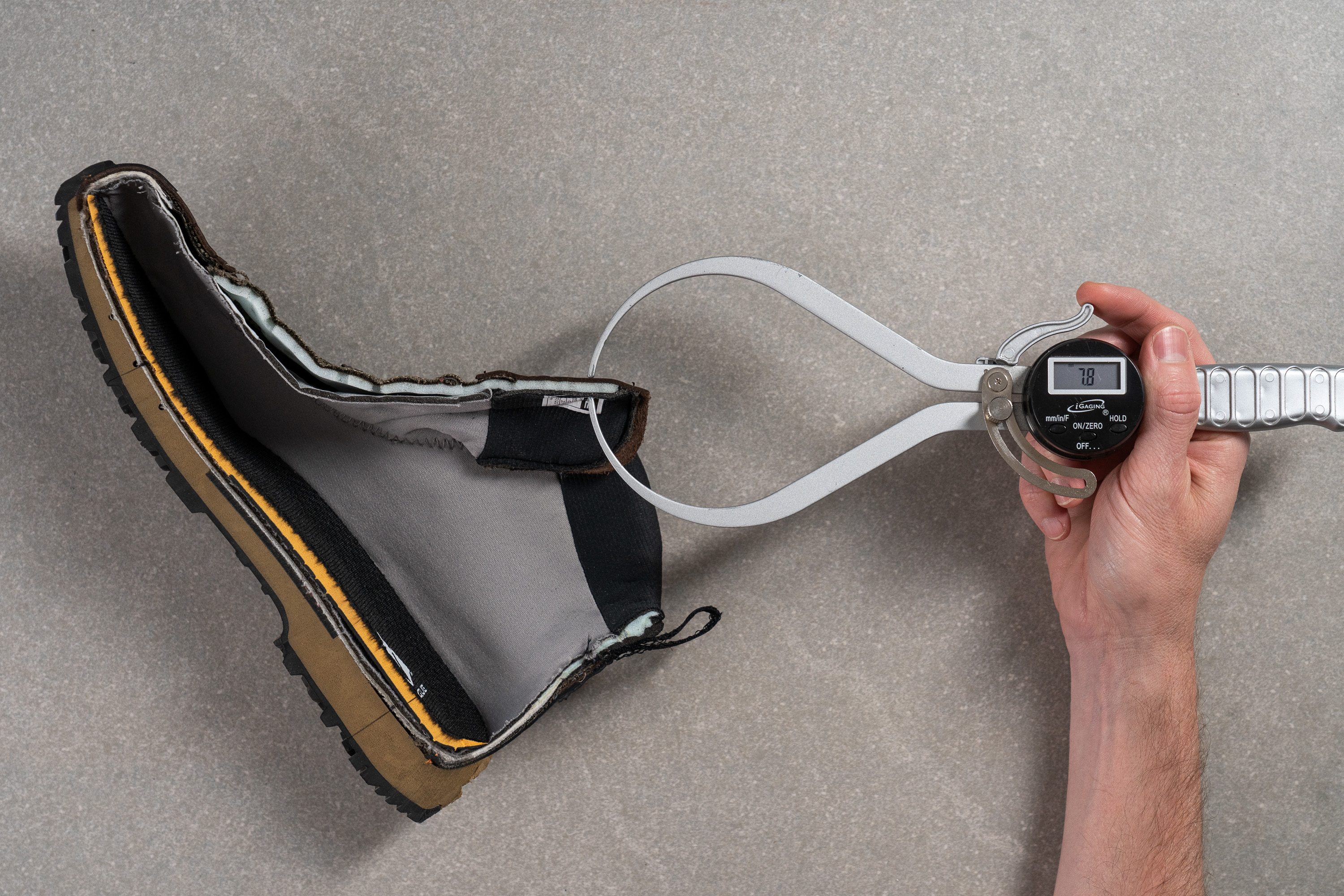
As you can see, the padding inside the Breeze is very minimal which leaves more in-boot space to take care of, especially if you have narrow feet or think ankles.
| Breeze | 7.8 mm |
| Average | 11.2 mm |
Tongue: gusset type
The tongue of the Vasque Breeze is fully attached to the upper on both sides making the boot feel like one unit on the foot.
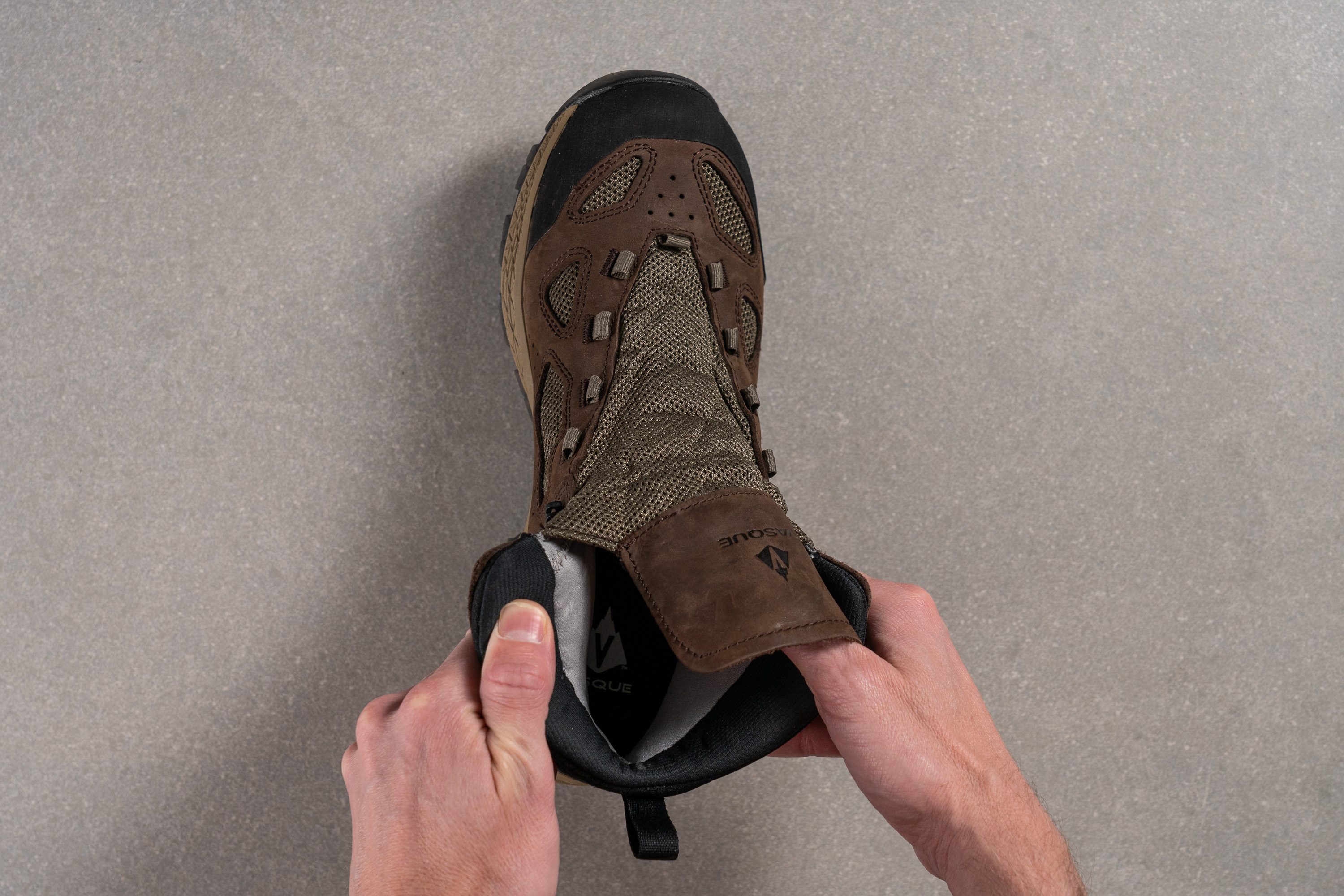
Not to mention that it allows for the waterline to be higher up the ankle without the water seeping inside.
| Breeze | Both sides (full) |
Price
The Vasque Breeze has a very moderate price point compared to other hiking boots on the market. We found that its value-for-money ratio is very fair and reasonable, especially considering its stability for backpacking.

For reference, it is also by far the cheapest backpacking boot on our roster.
| Breeze | $160 |
Heel tab
A large and securely attached finger loop at the back of the boot really helps with the on-and-off.

| Breeze | Finger loop |
Sustainable materials
When the Vasque Breeze was reintroduced in 2022, the addition of sustainable materials was one of its biggest updates. Here is the percentage of recycled materials in various parts of the boot:
- Upper mesh (75%)
- Heel contour (60%)
- VasqueDry waterproofing (25%)
- EVA insole (20%)
